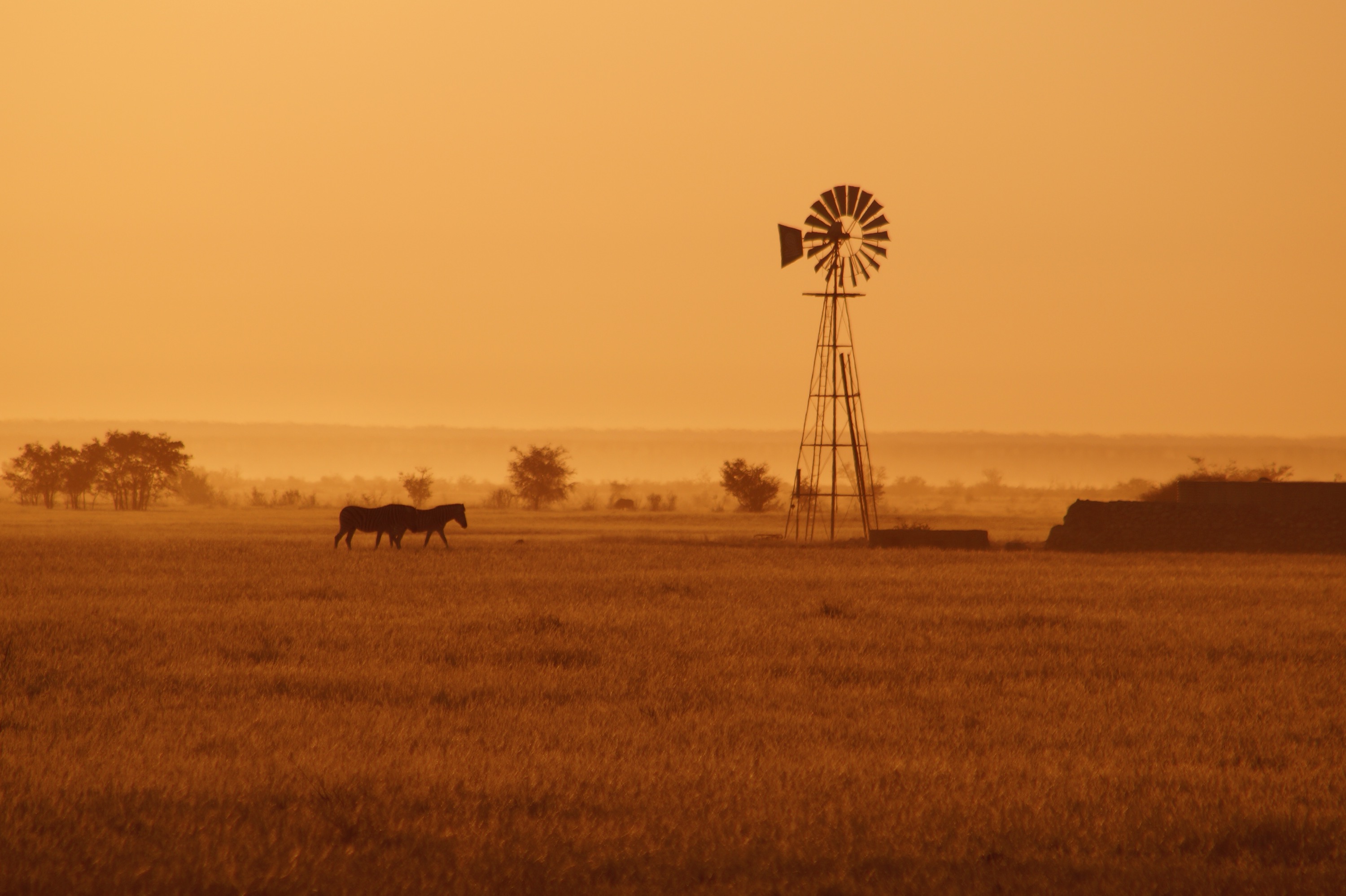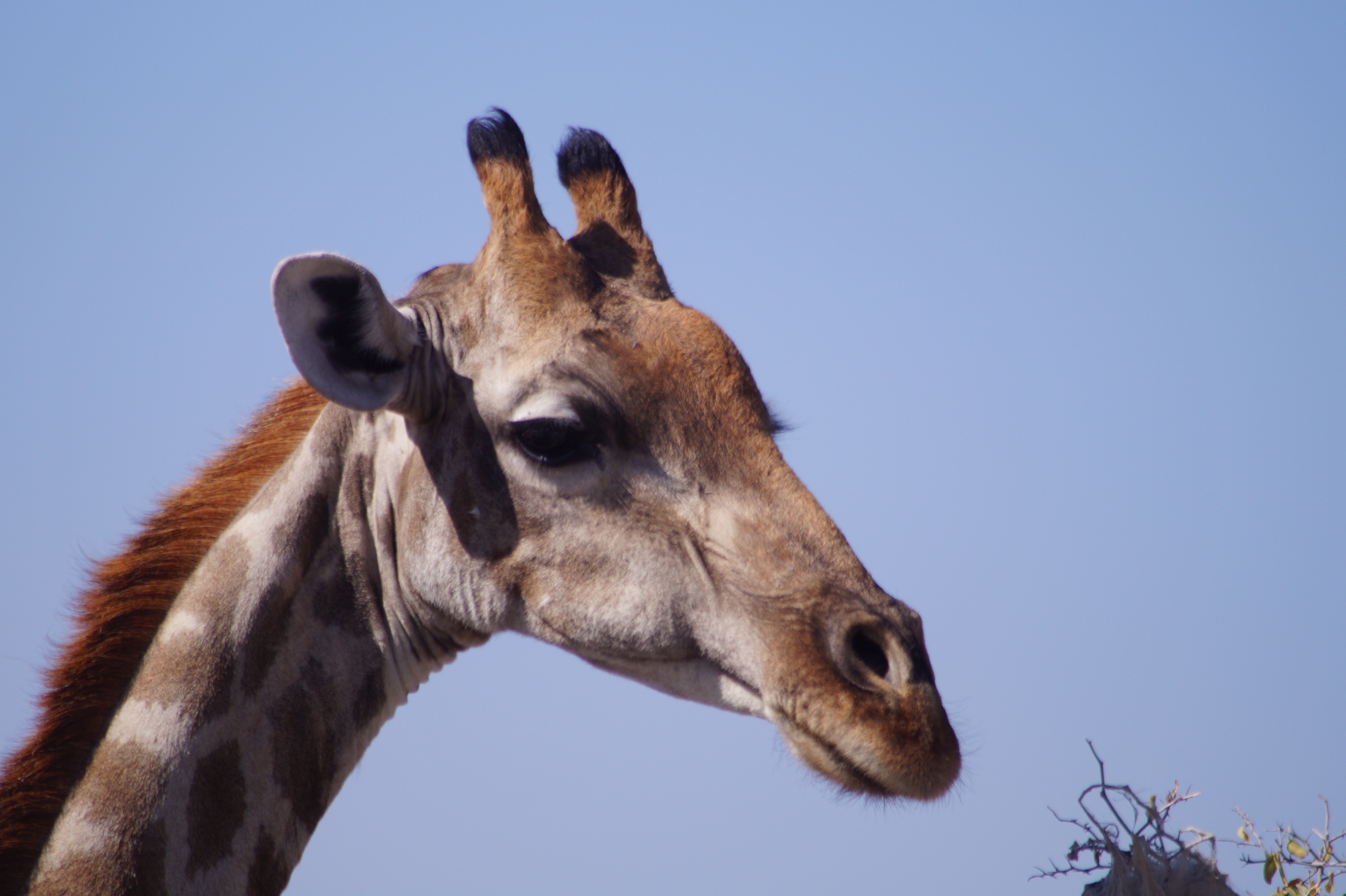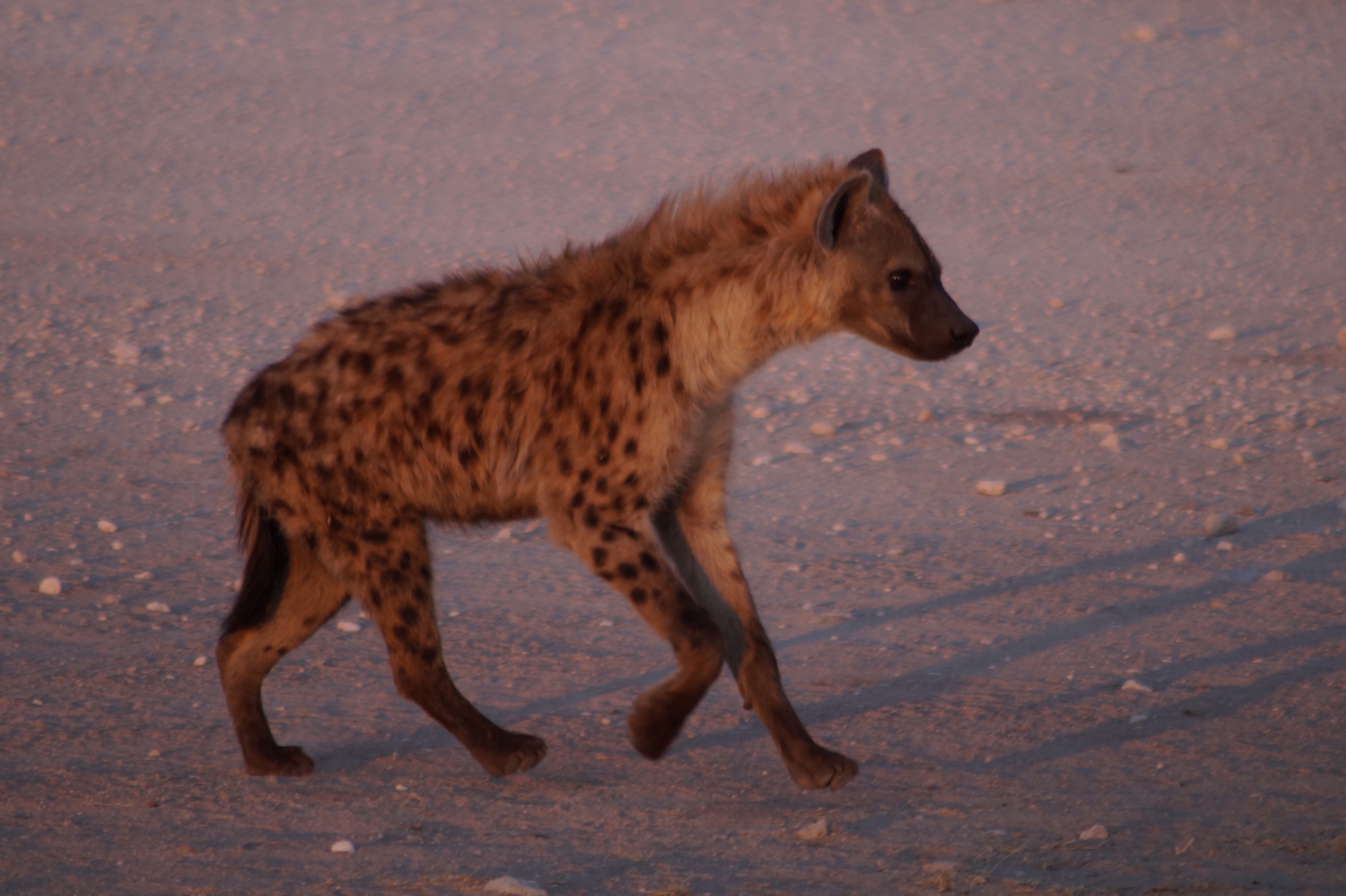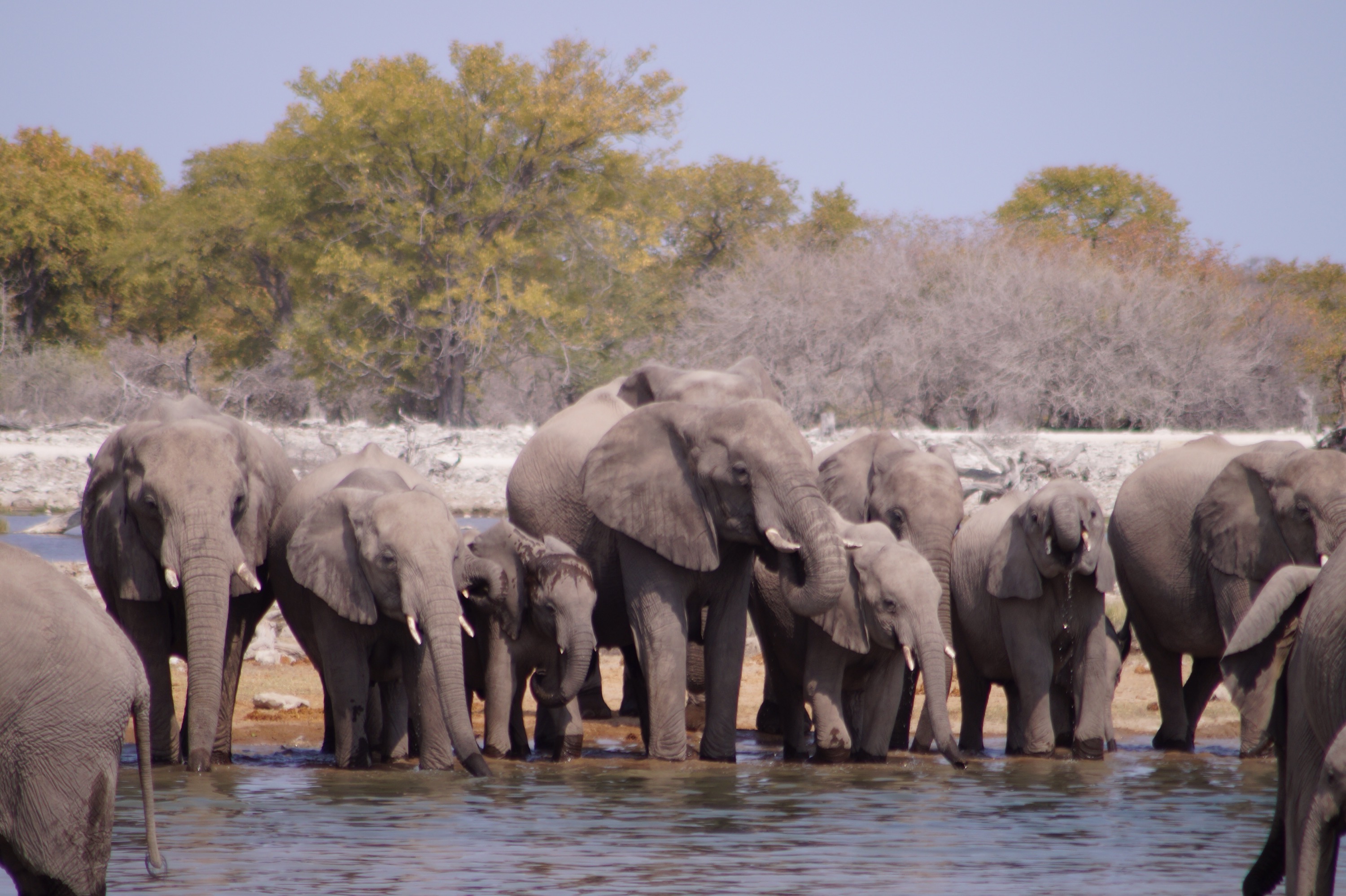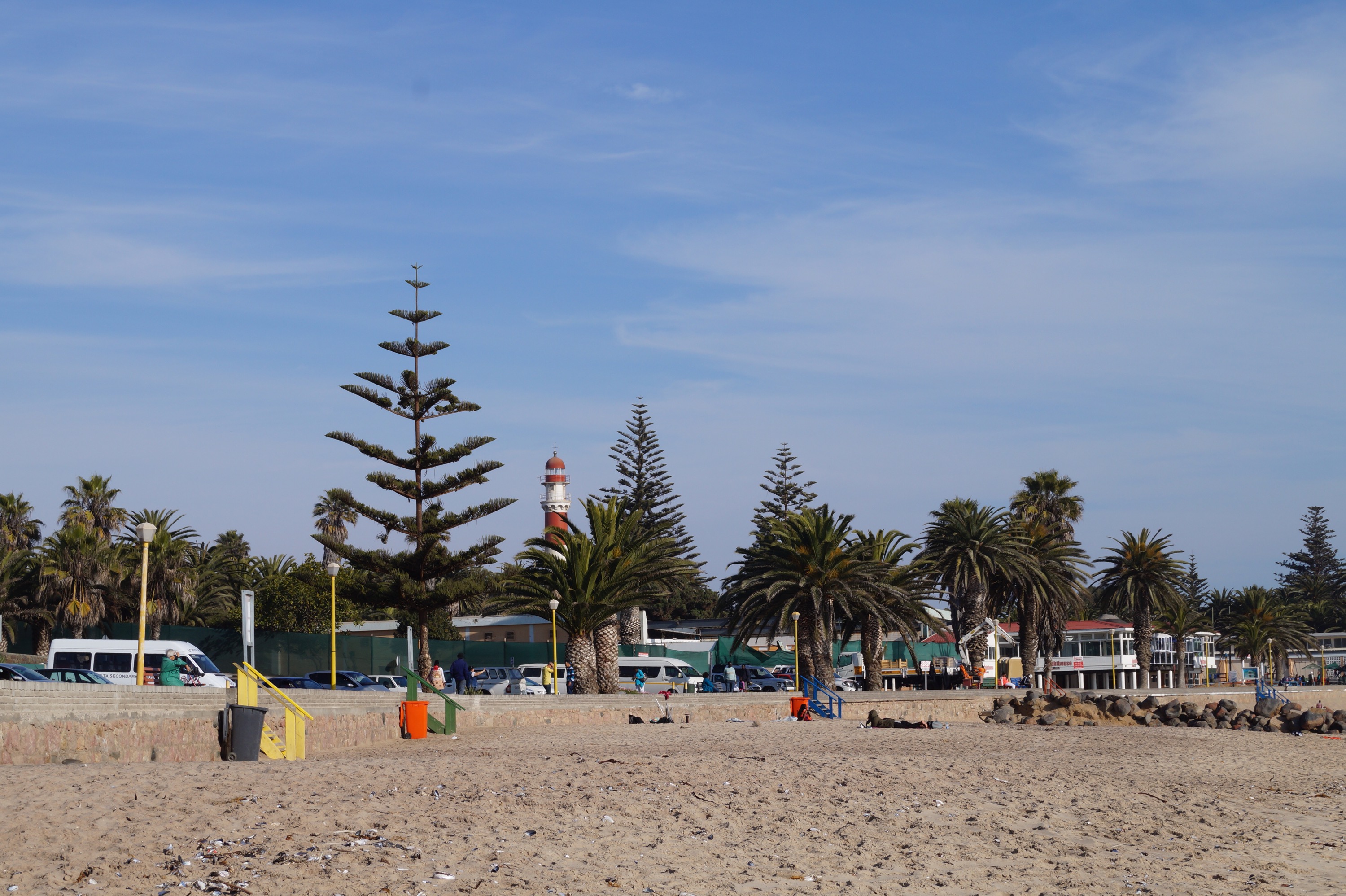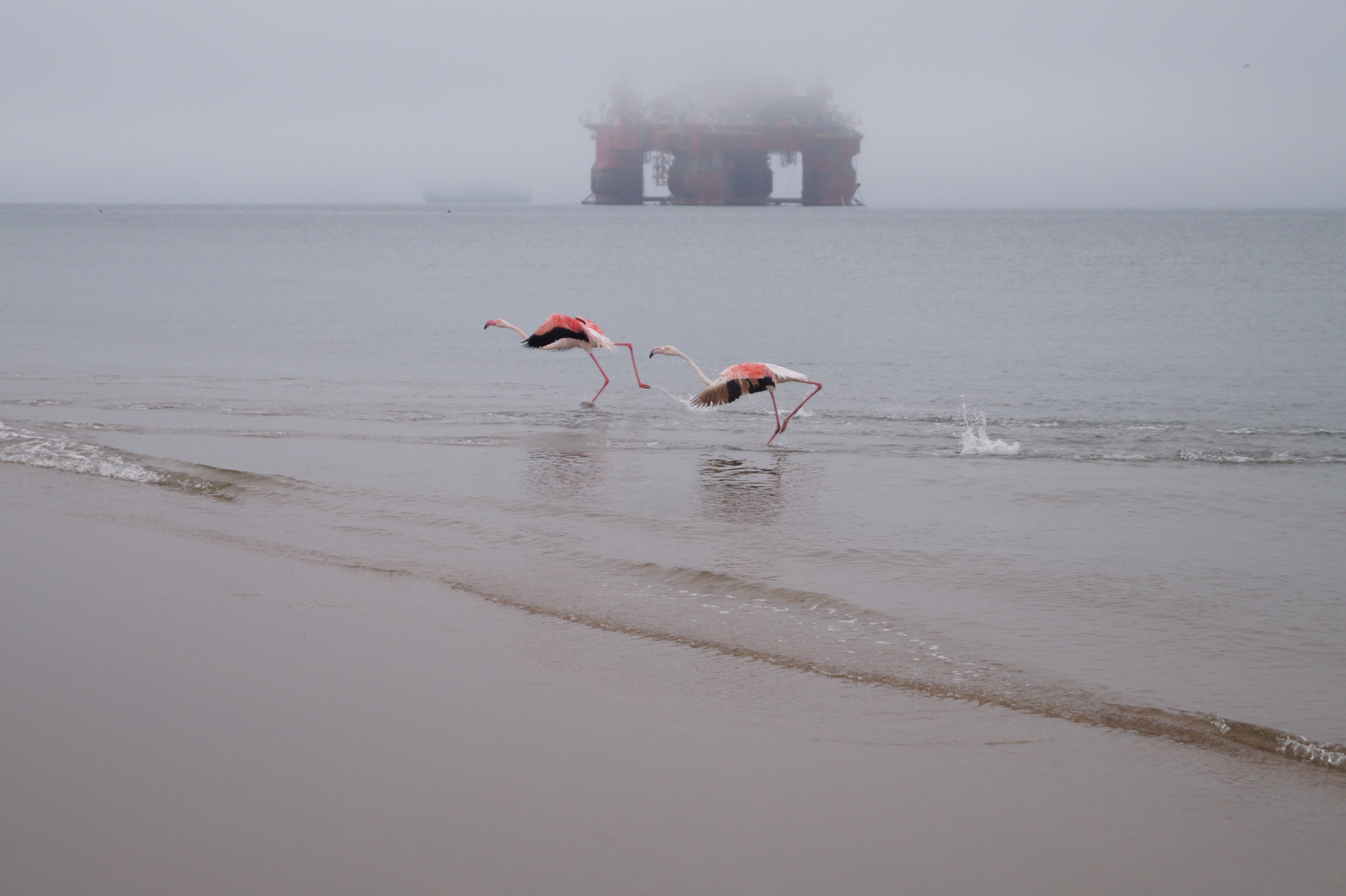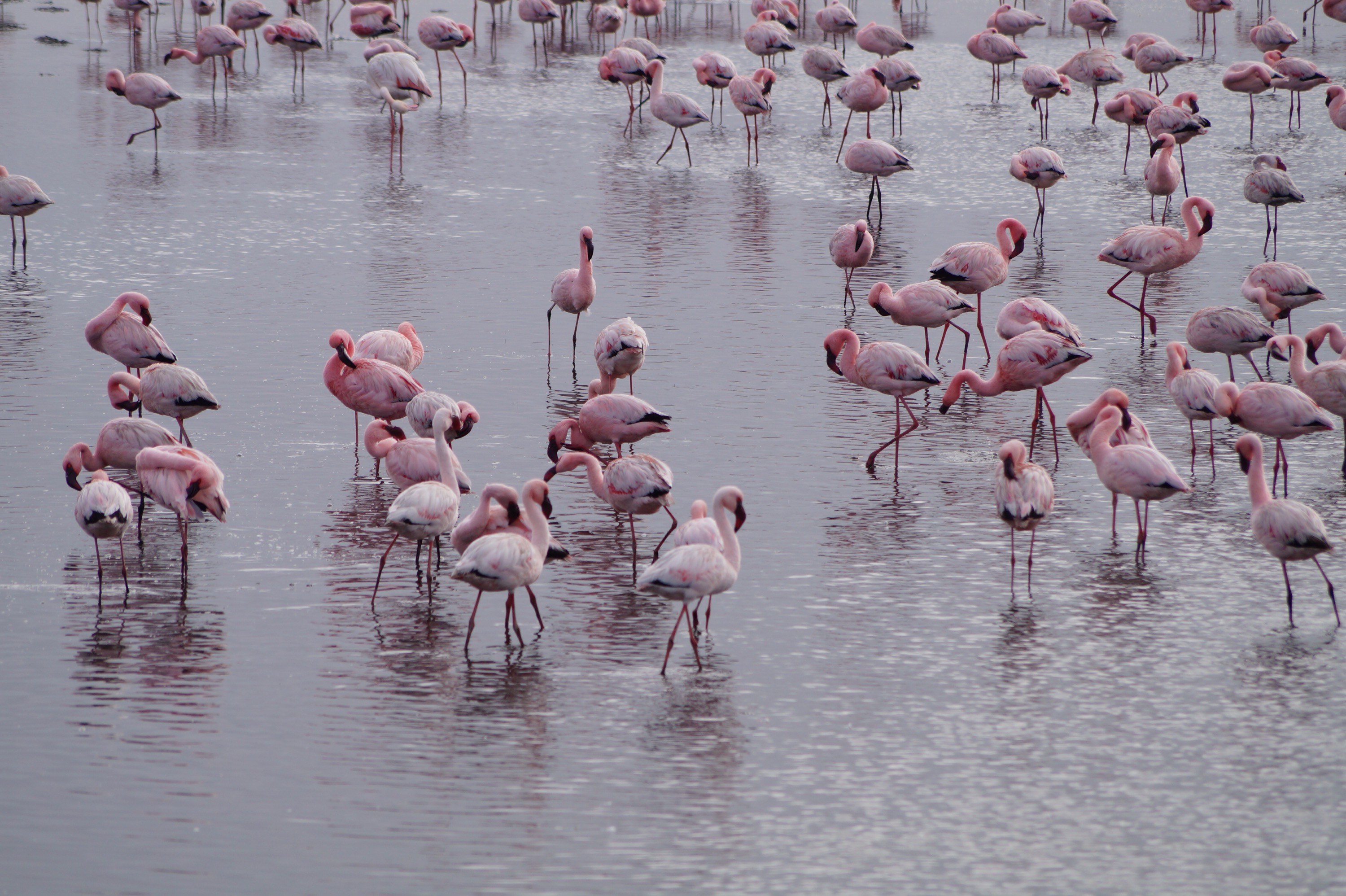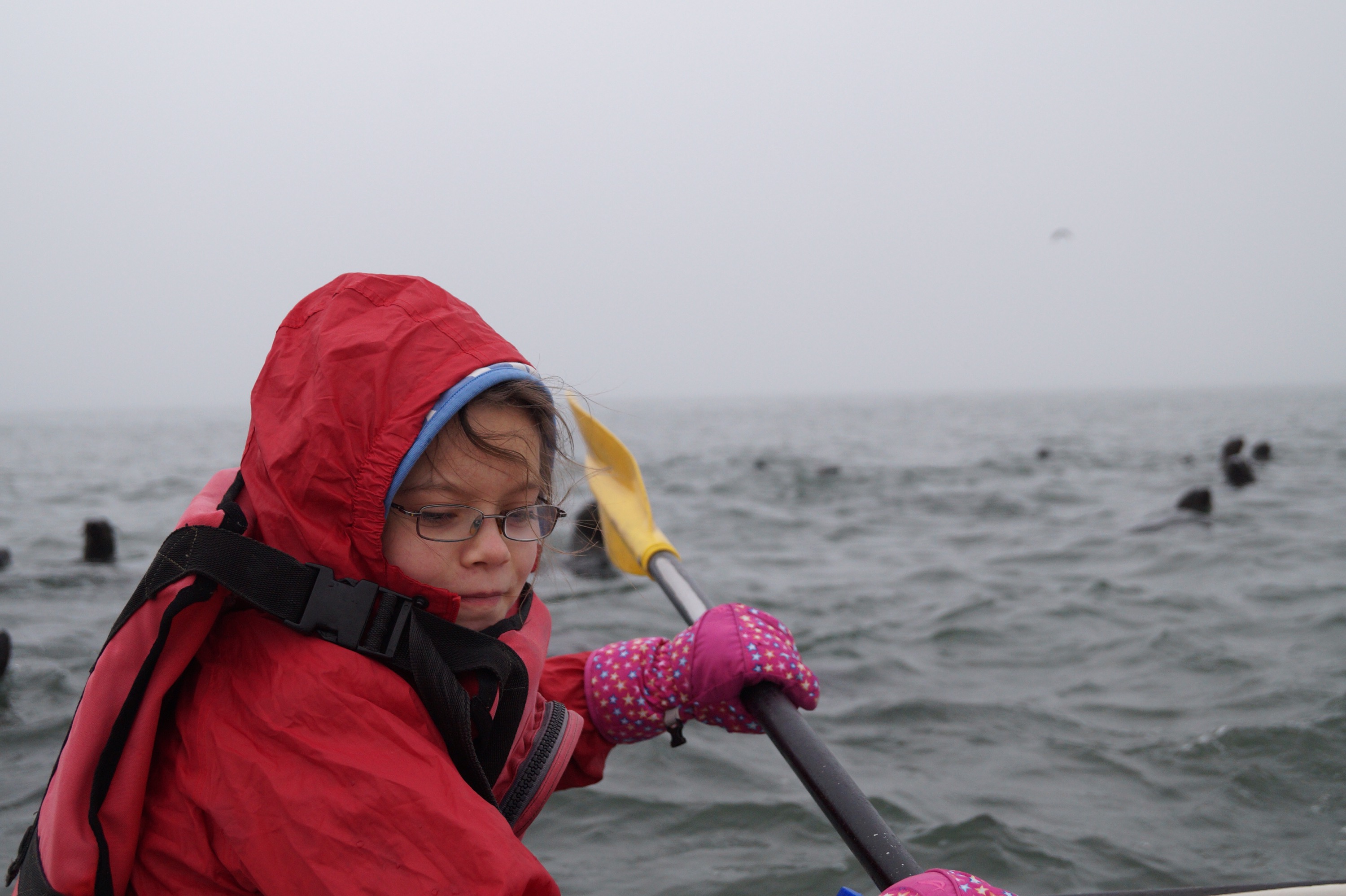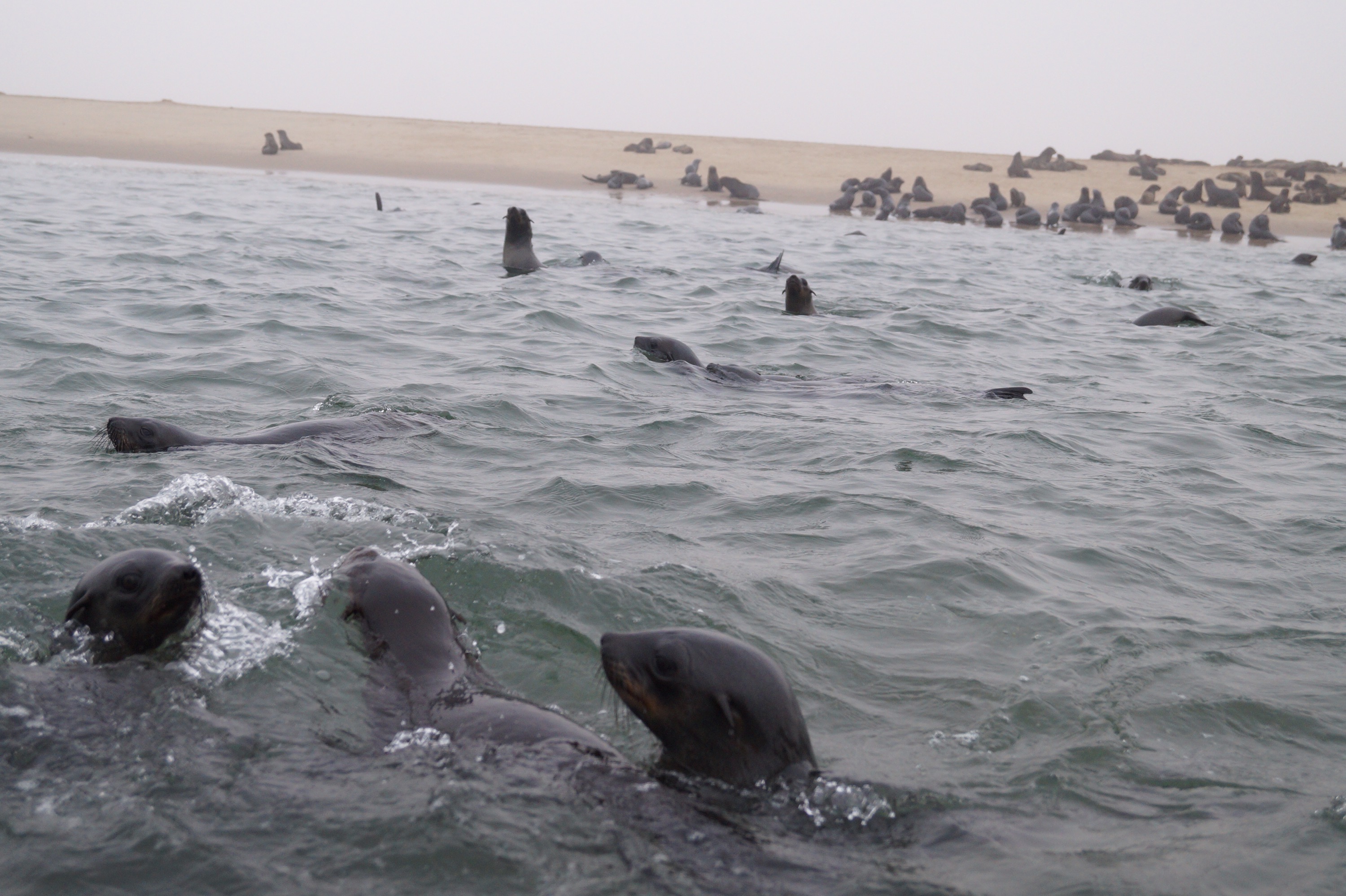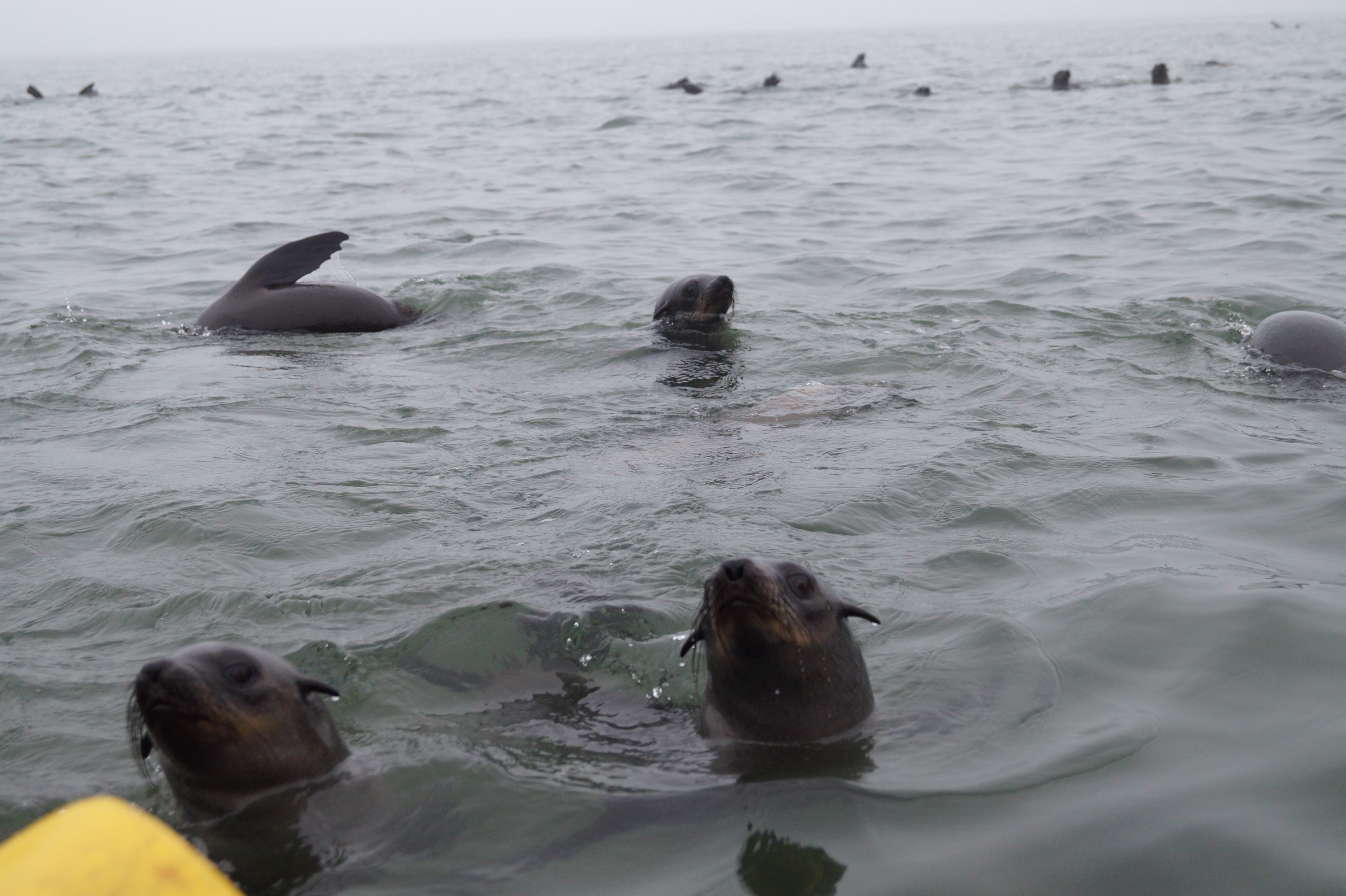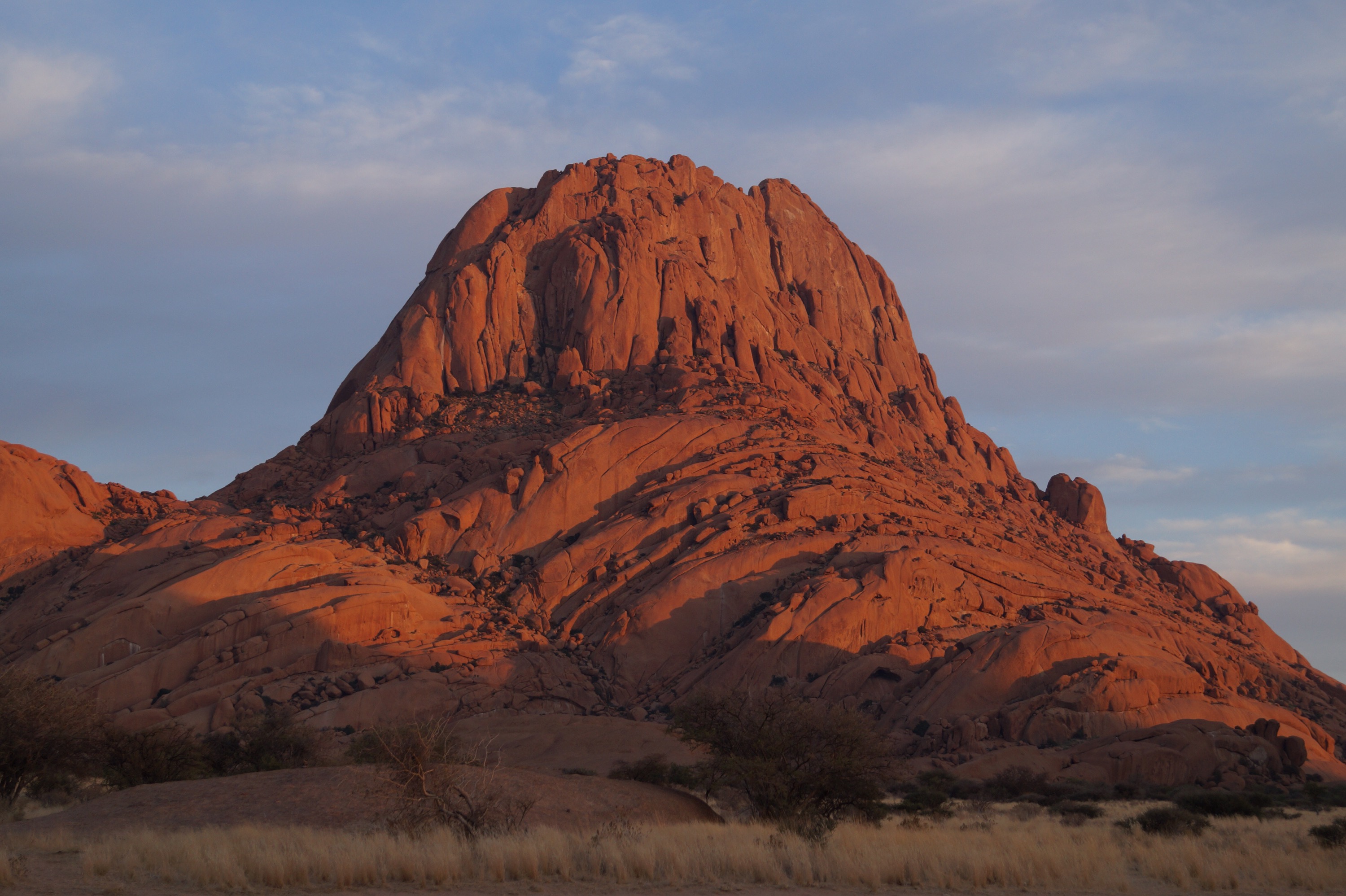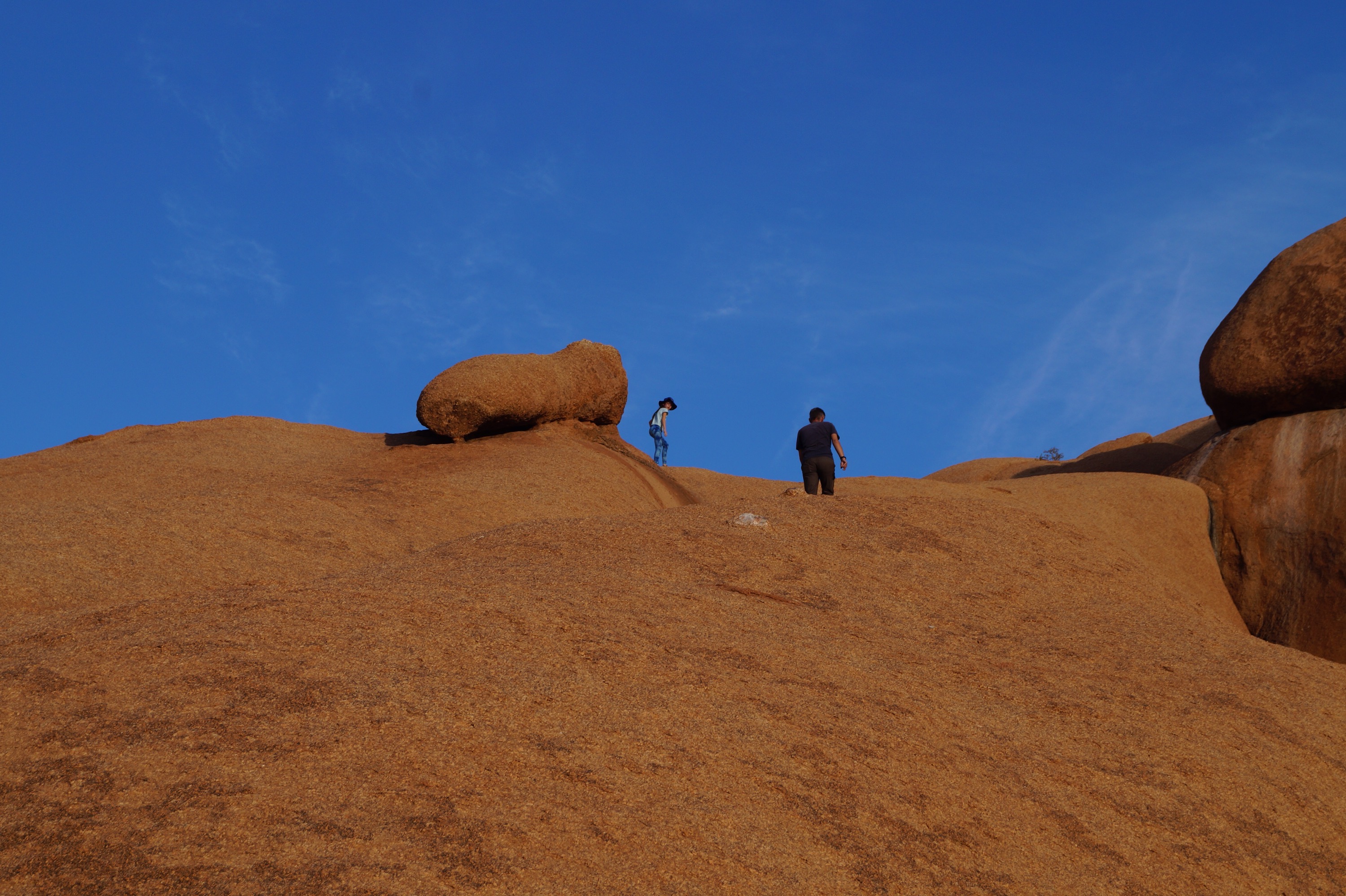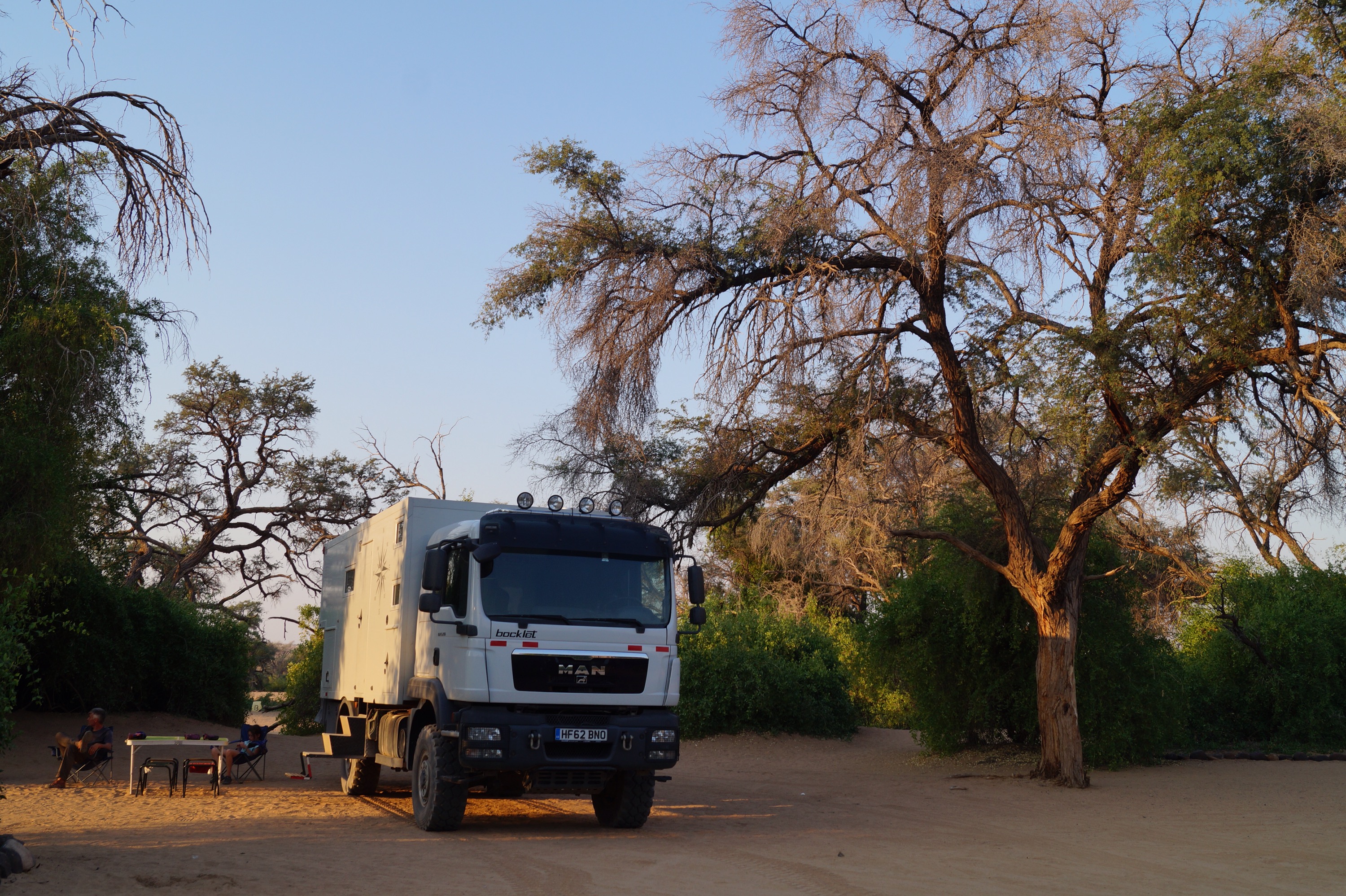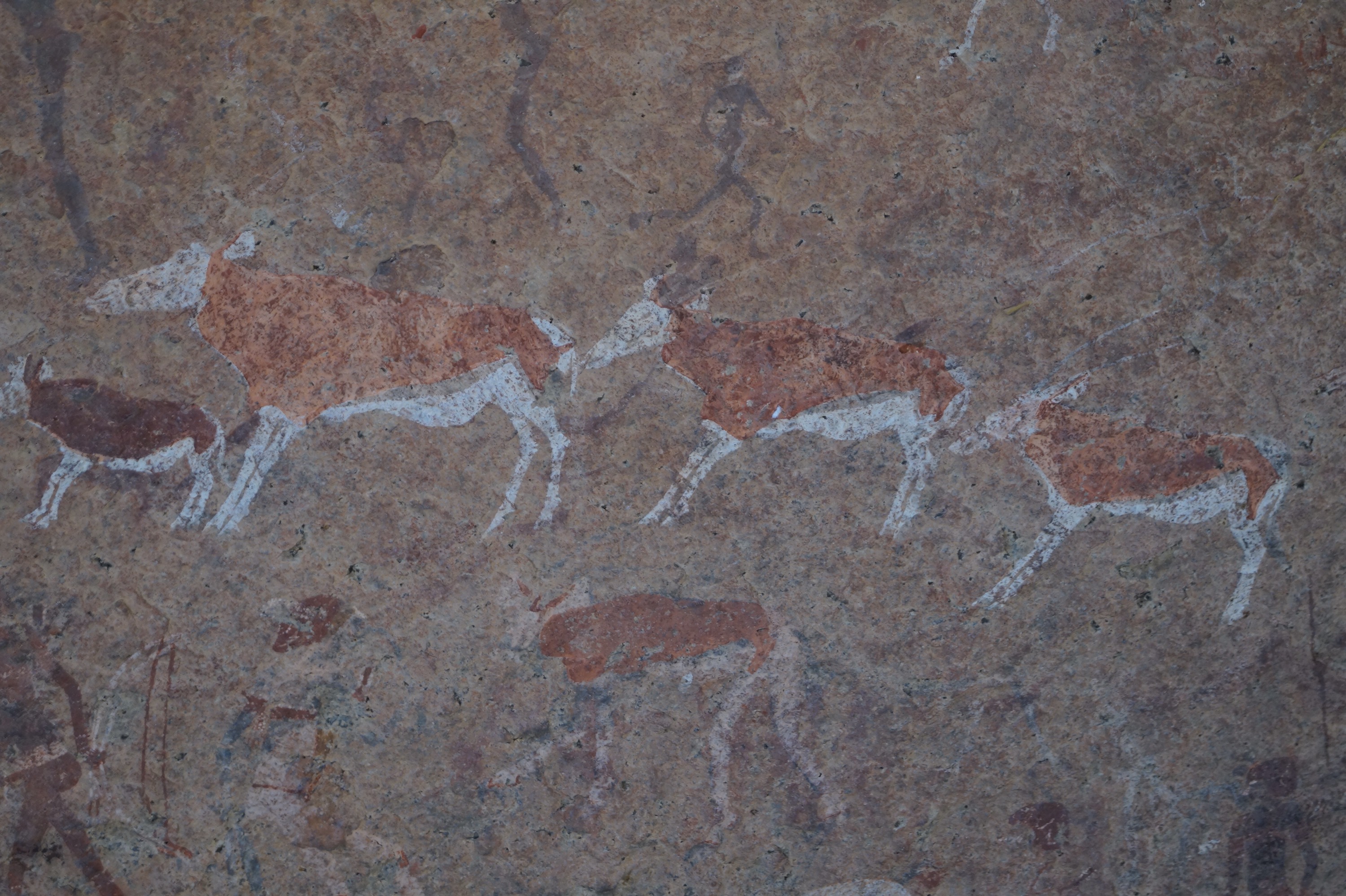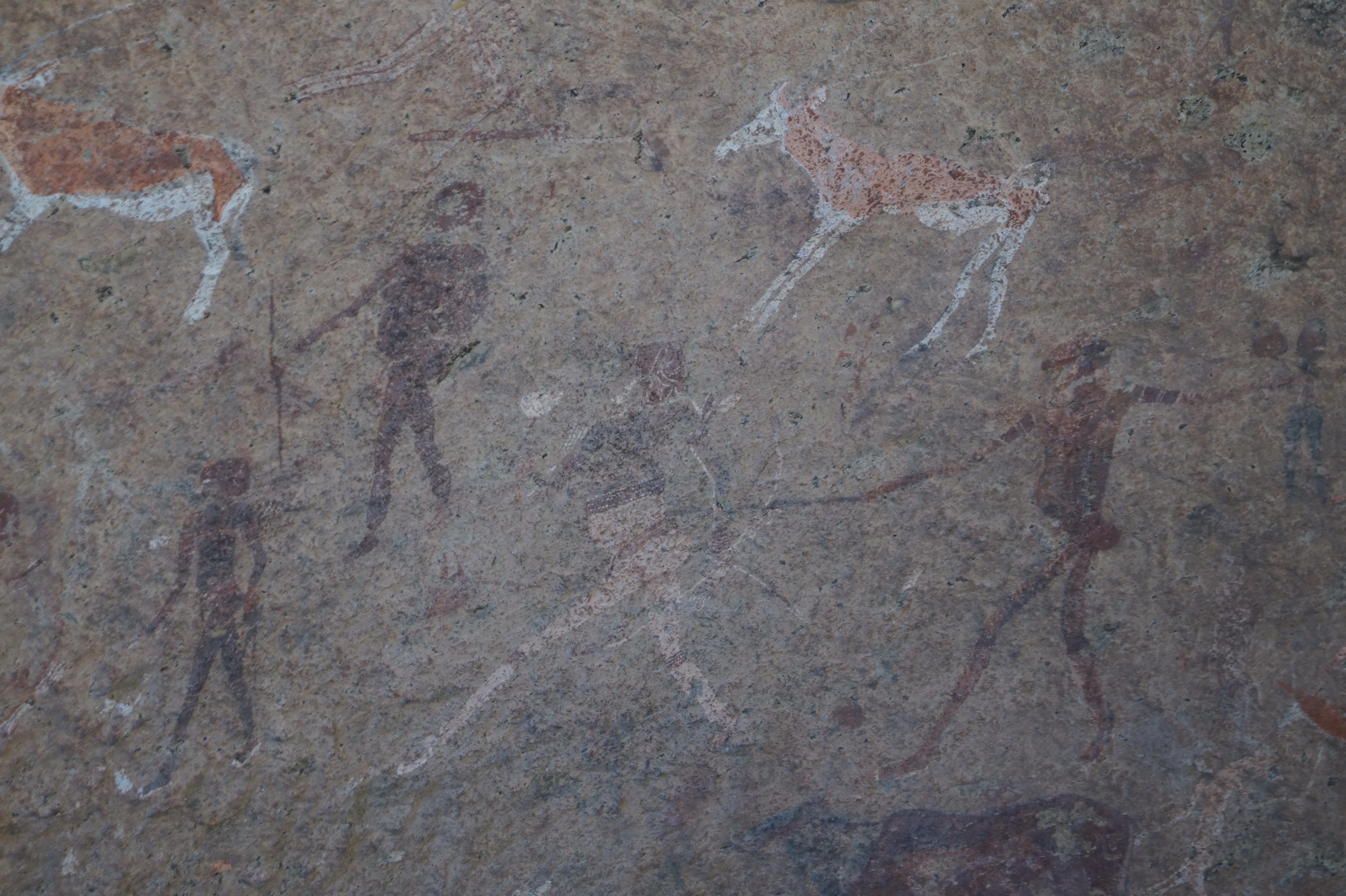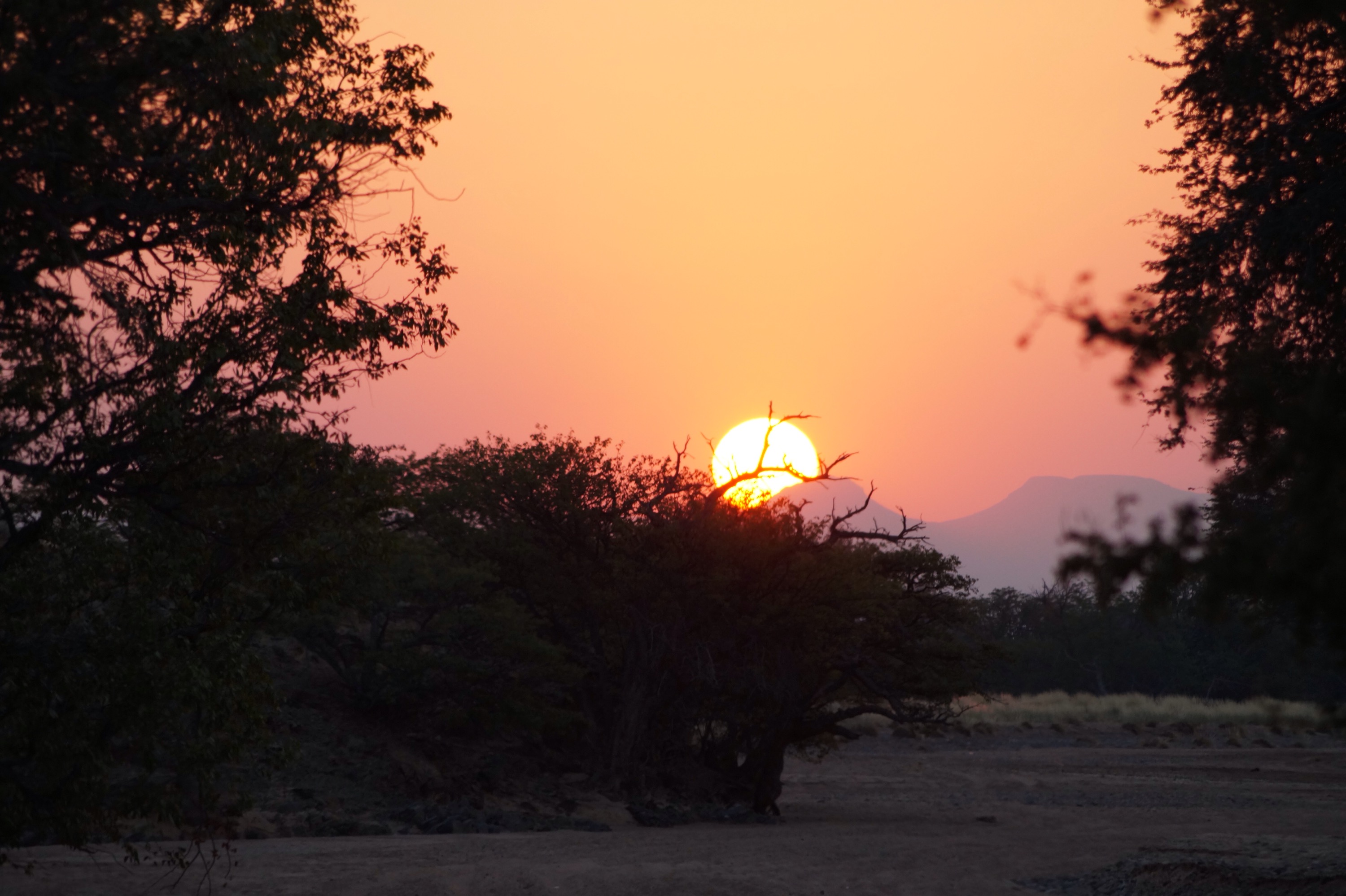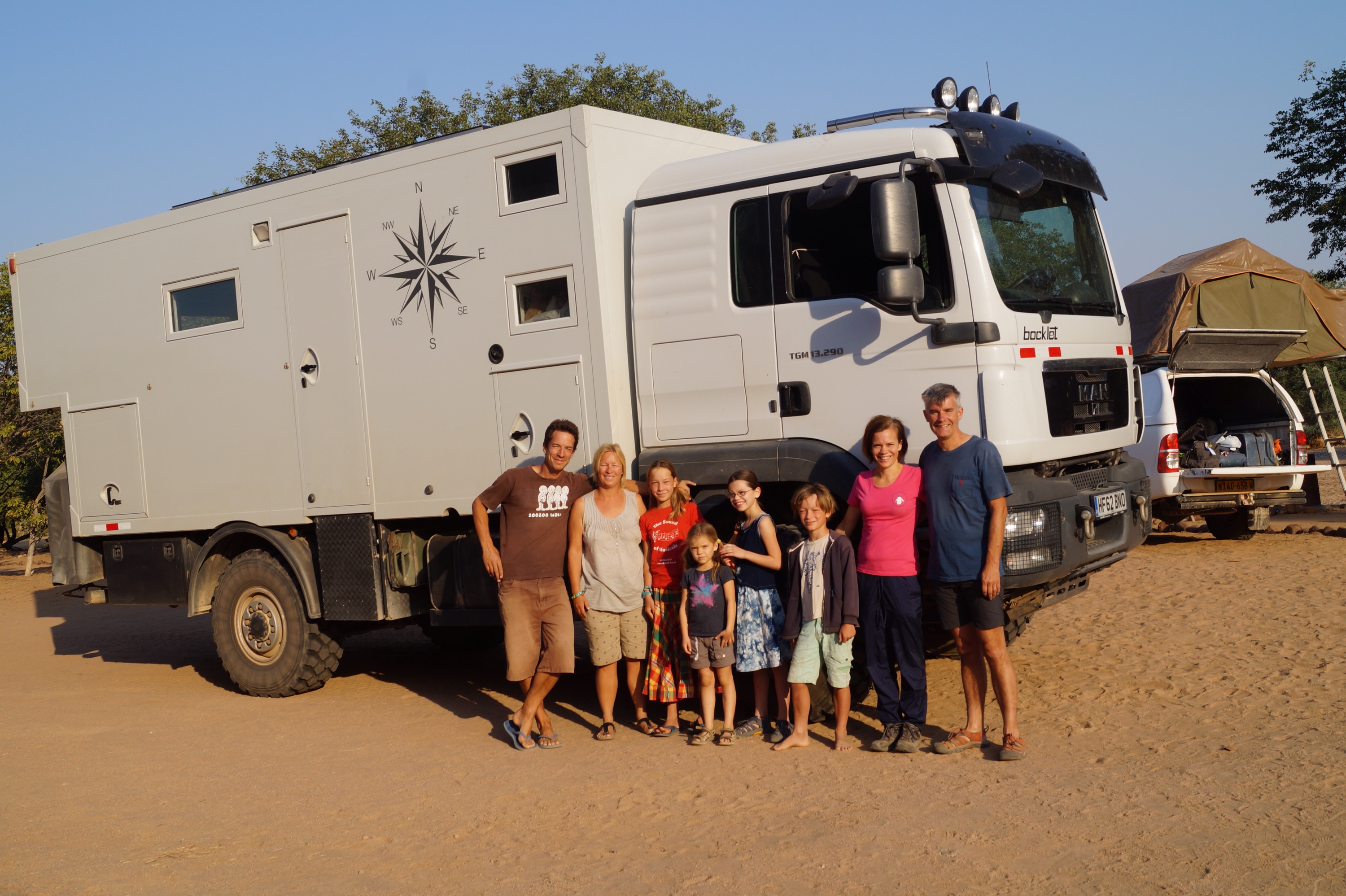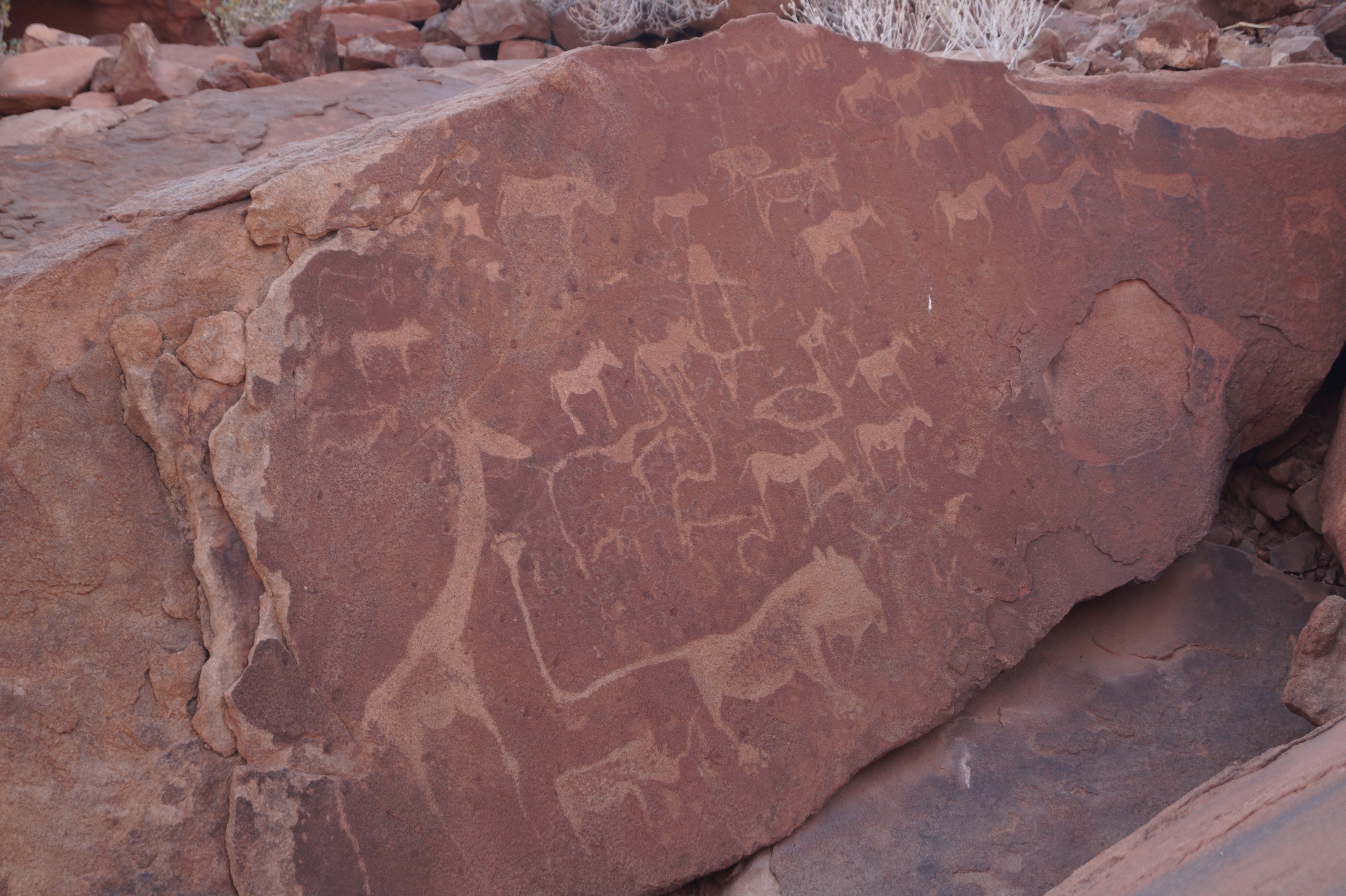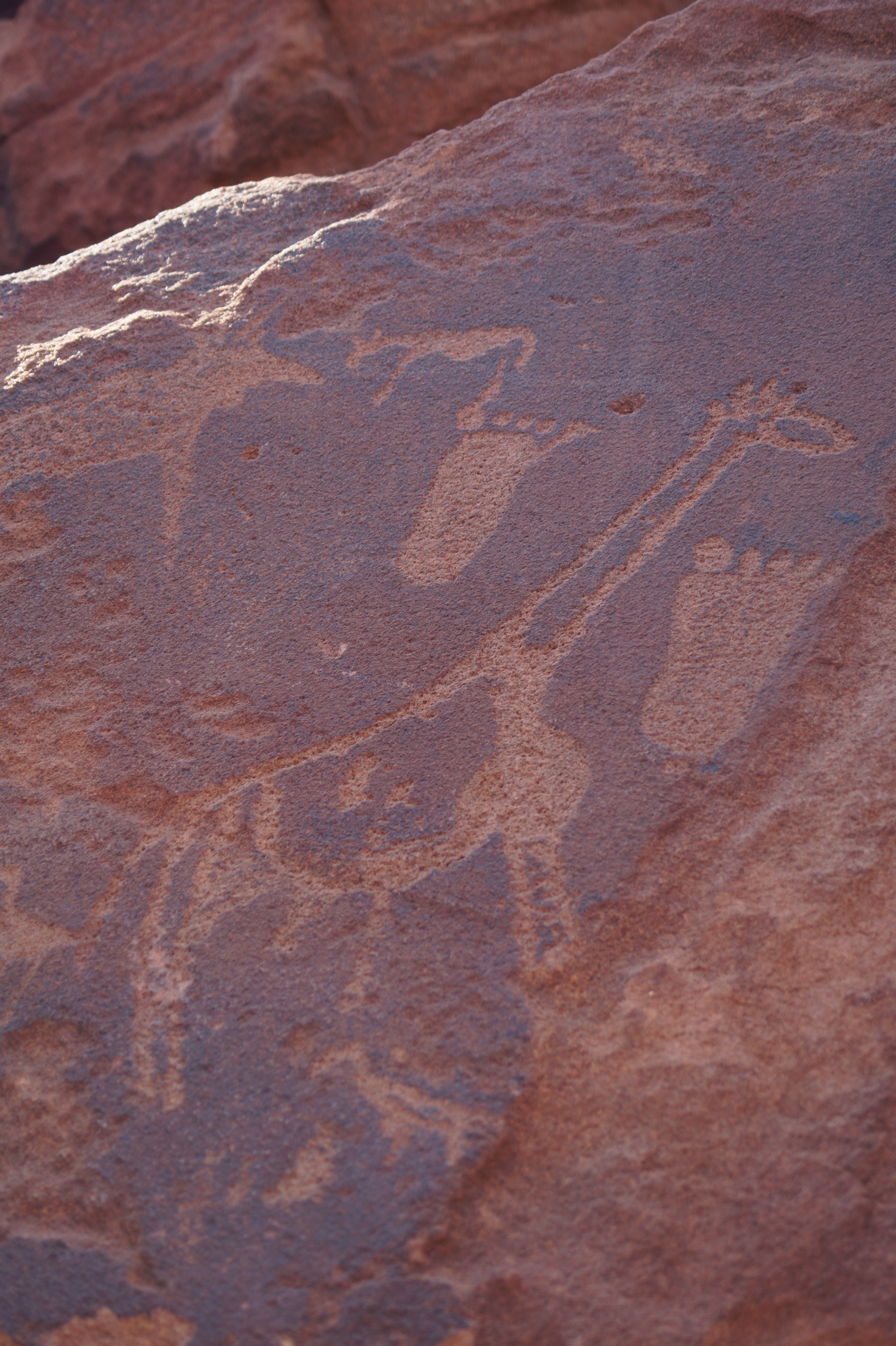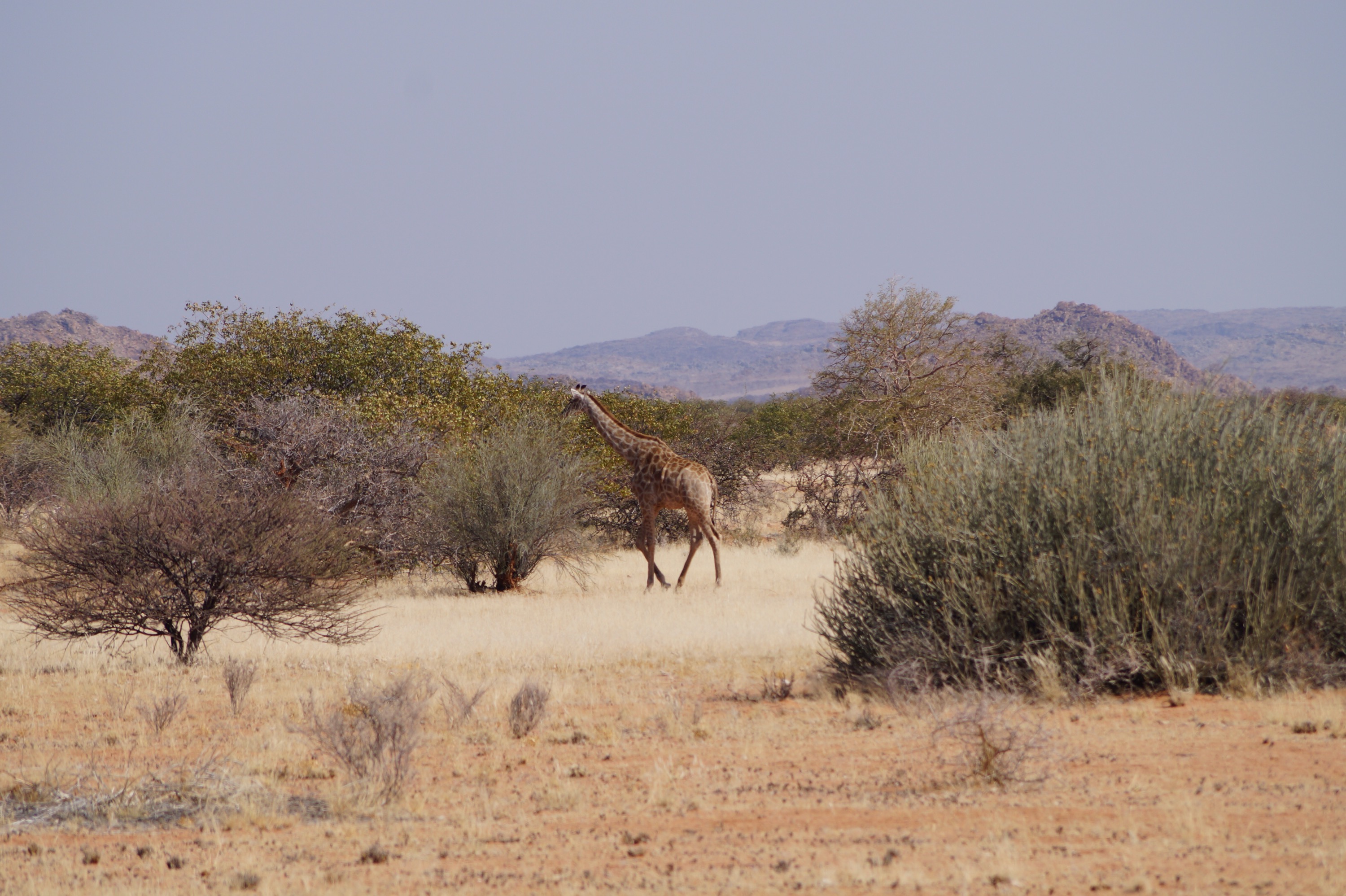With their bodies protected against the sun and insects by a covering of red ochre mixed with butter, red hair extensions, goat skin skirts and crowns the Himba ladies were an amazing sight. Like any group of close friends they chatter, gossiped, teased one another and answered our questions through John, our guide. As they got used to us they started to ask us questions too; about the children, their schooling and things like that. As I admired one of the tiny newborns, they asked me where our girls had been born and there was much chatter and comments when I told them the girls were born at home with my Mum. They said it was lovely to have families visiting them as usually it was just couples.
Lucy wanted to stay longer as she fell in love with the baby goats after one of the ladies asked if she would like to carry them from the kraal into the shade. Although she laughed and declined the ladies' suggestion that she could swap places with her daughter for a few weeks.
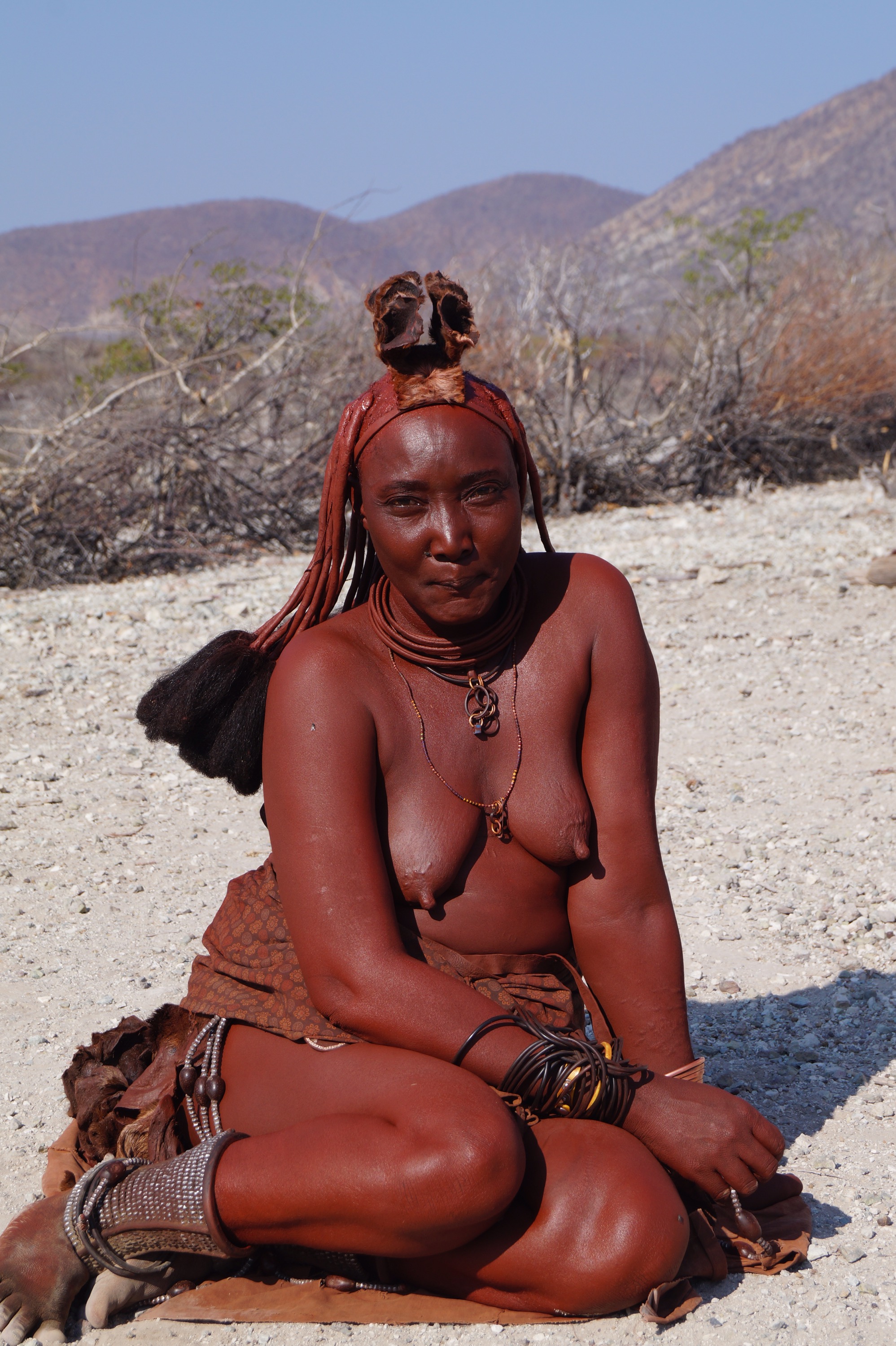
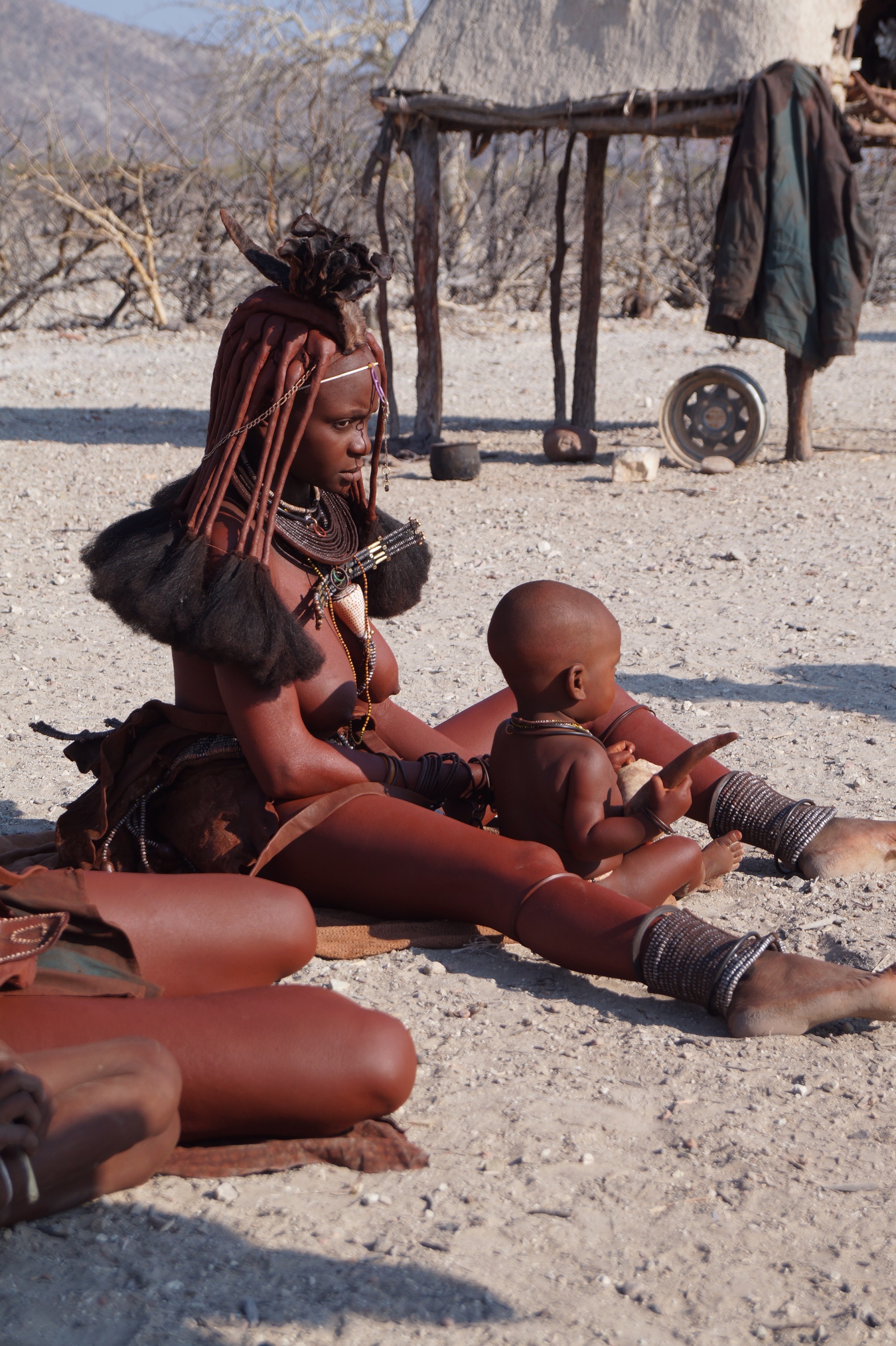
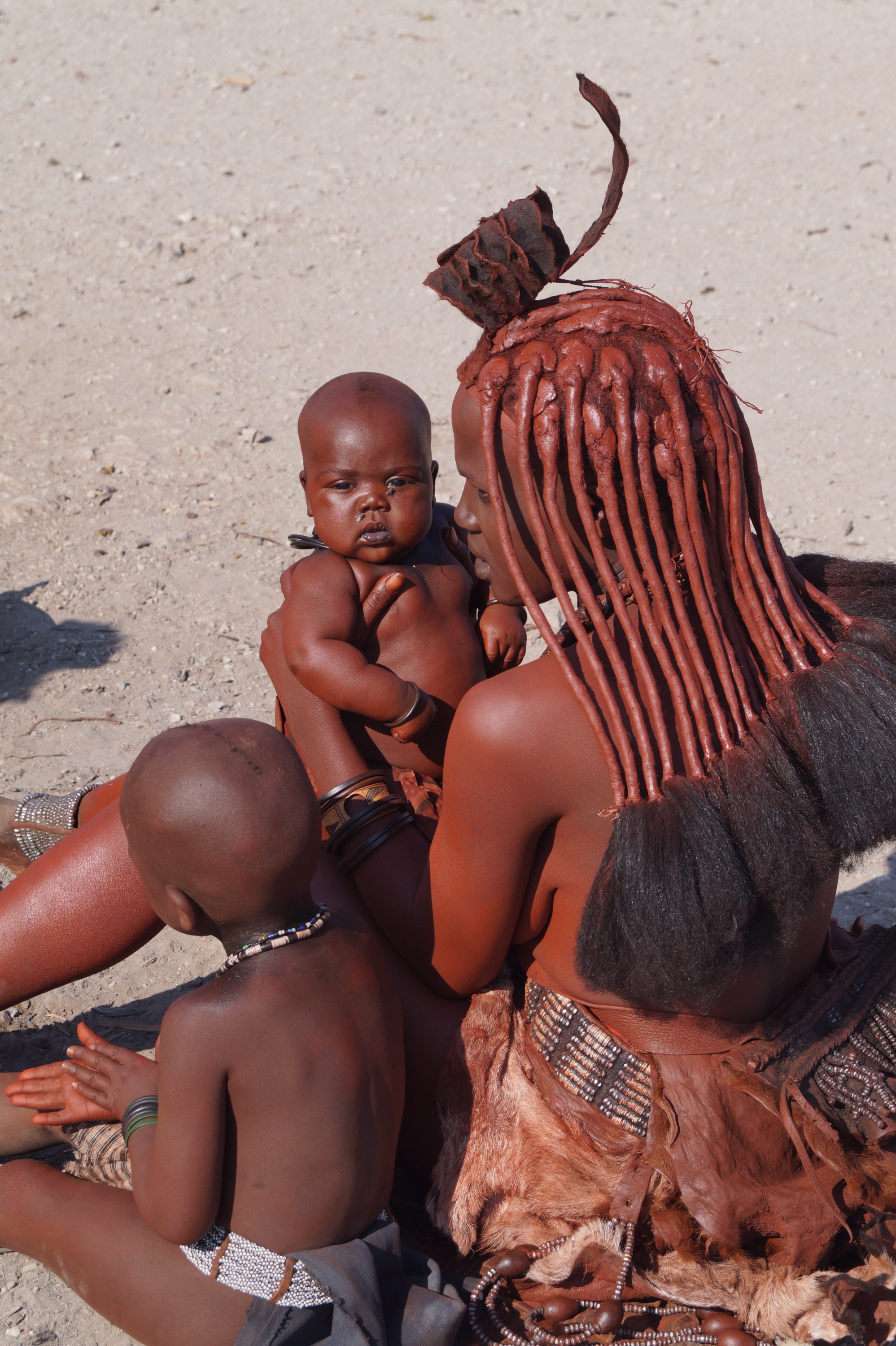

We had asked around at Epupu Falls campsite if there was a guide who could take us out to see a Himba village. We had seen them scattered around the area and wanted to know more about their culture. John, described himself as "Modern Himba" having given up traditional clothing, been to school, learnt English and now worked as a guide taking visitors out to see different villages. He explained that we would take a gift of maize meal, cooking oil, sugar and salt to be shared by everyone, to a local village. Once there he would ask permission of the Headman to ask if we could visit. The villages are just a collection of a few conical huts with a goat kraal in the centre. The Himba are polygamous, the village is just one family but the village we went to had two families. One man and most of the older children were away herding the family goats and cattle, it just just the Headman, ladies, toddlers and babies left in the village. After shaking hands, exchanging greetings which John had taught us, they showed us around. It's always slightly awkward meeting new people but after we declined John's suggestion to take photos straight away, everyone soon relaxed. It was fascinating to hear how the ladies used the smoke of aromatic bark to keep themselves sweet smelling, as water is a scarcity. That their amazing hairstyles are actually extensions with ochre rubbed around them and the hair tufts at the end are actually men's hair from when they cut it stitched on. They explained the meaning of the different adornments and hairstyles. Each of the wives have their own tidy hut with just space for a cow skin bed mat and a few belongings; and the husband shared his time between them. We bought some jewellery and baskets before we left, all with a slight red hue from the ochre to remind us of our visit.
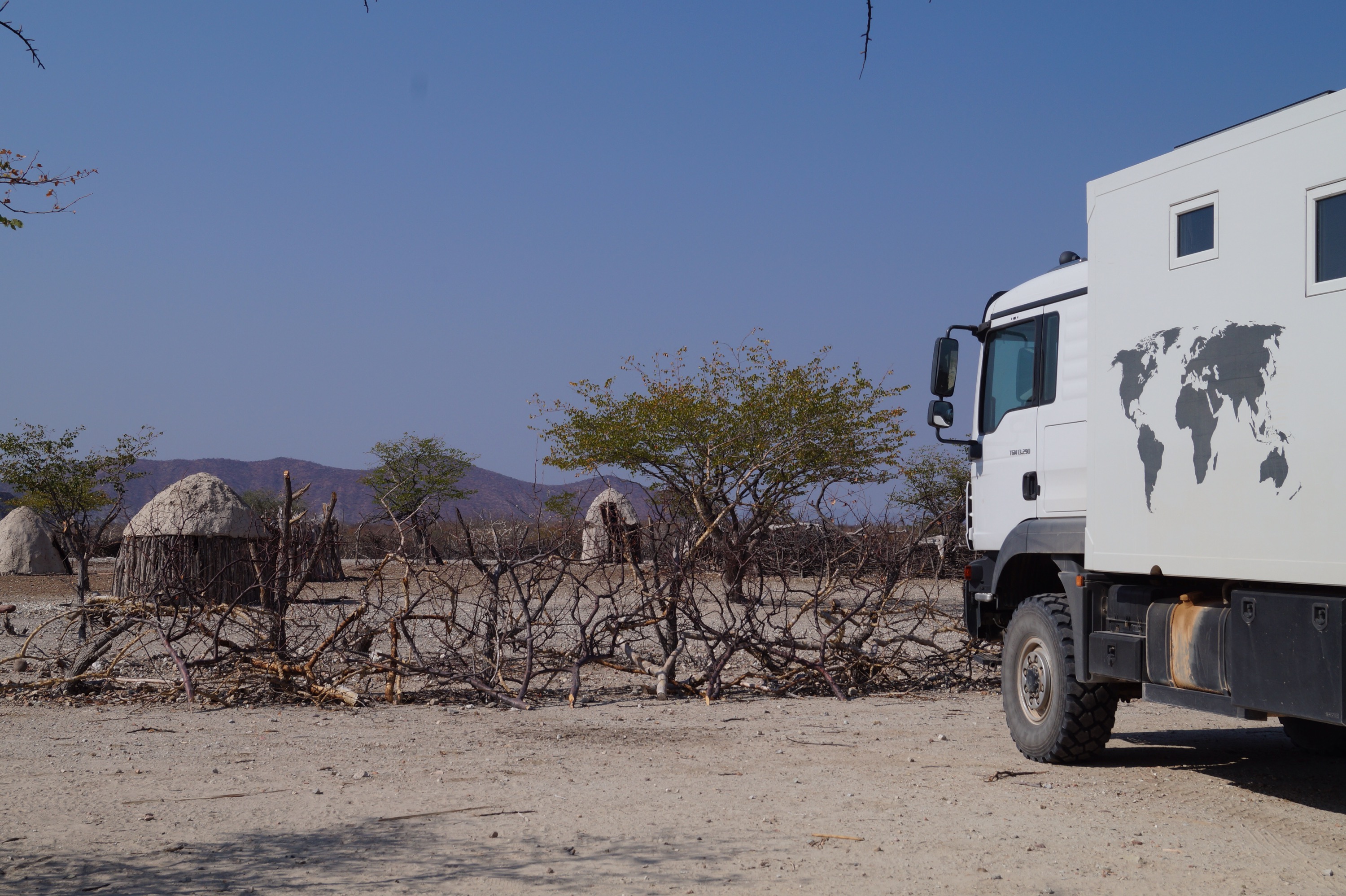

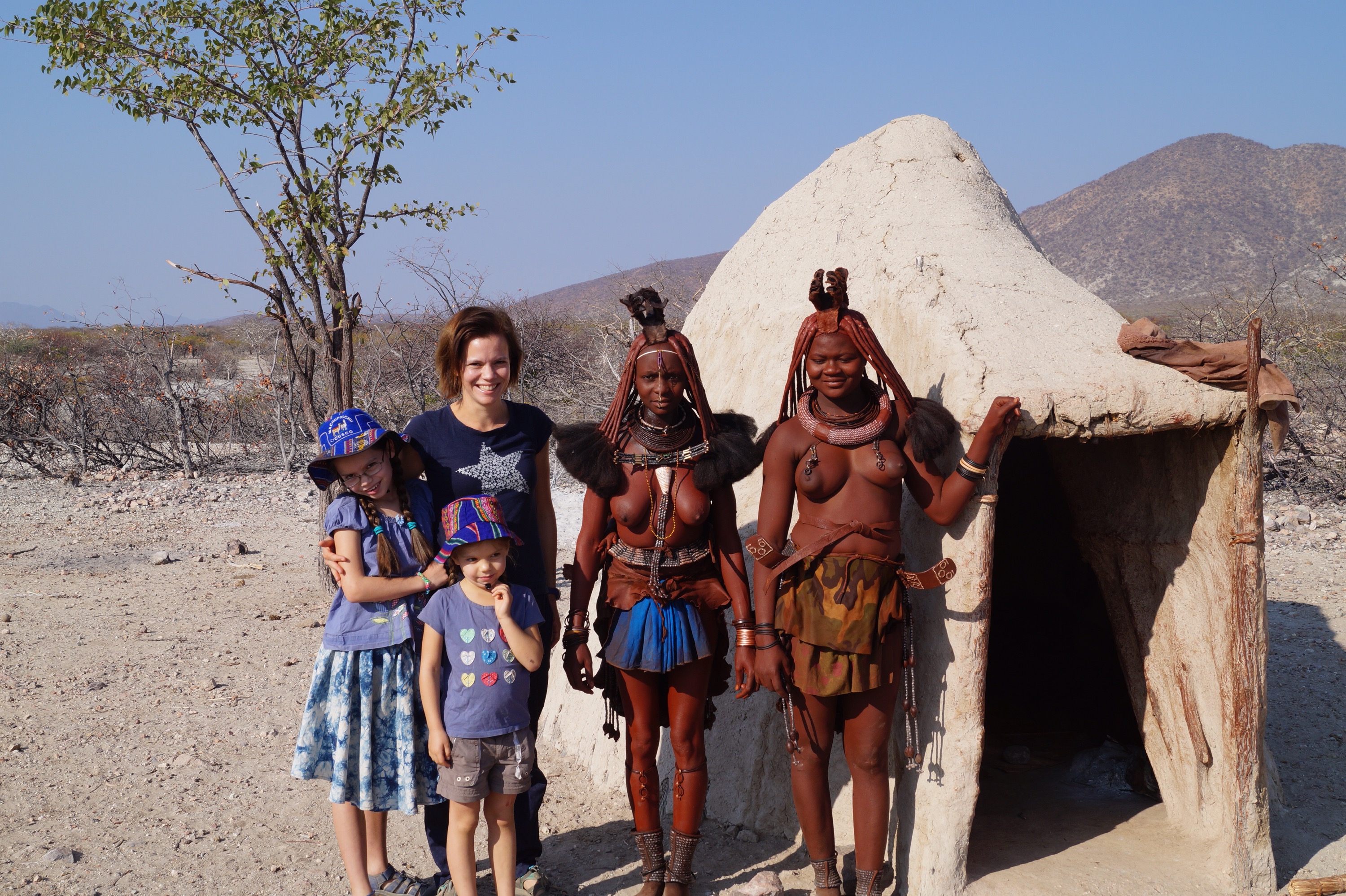
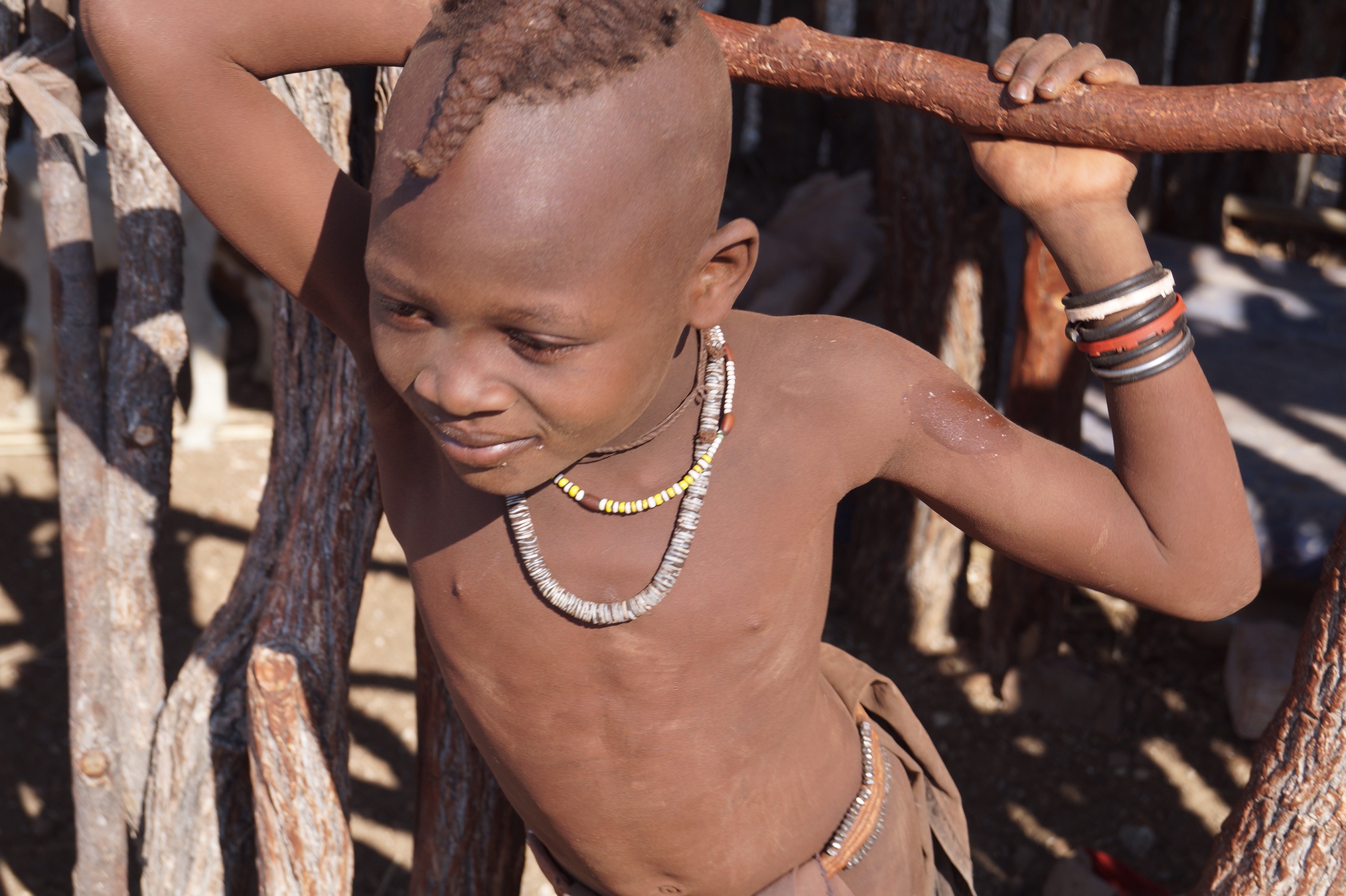
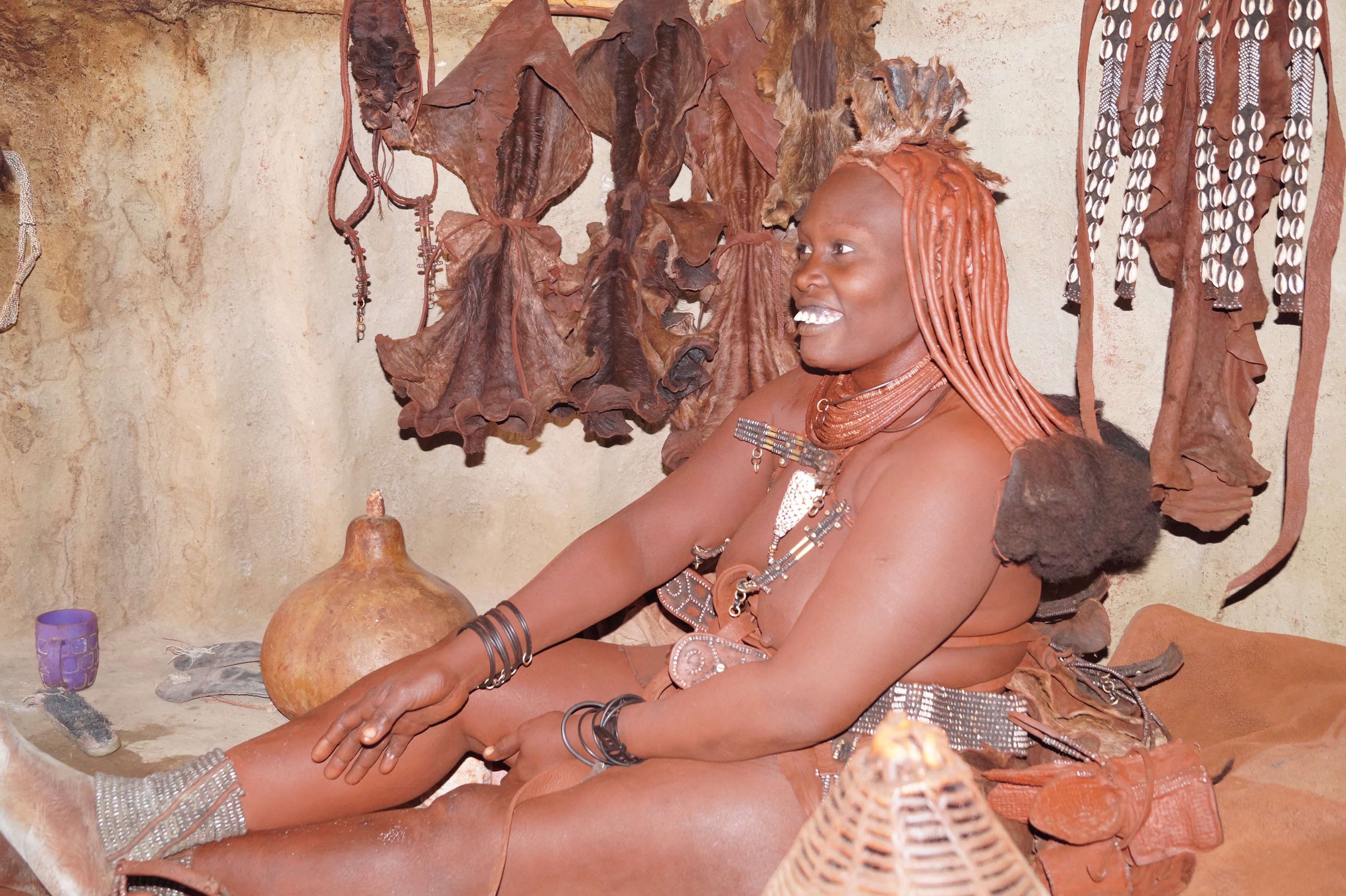
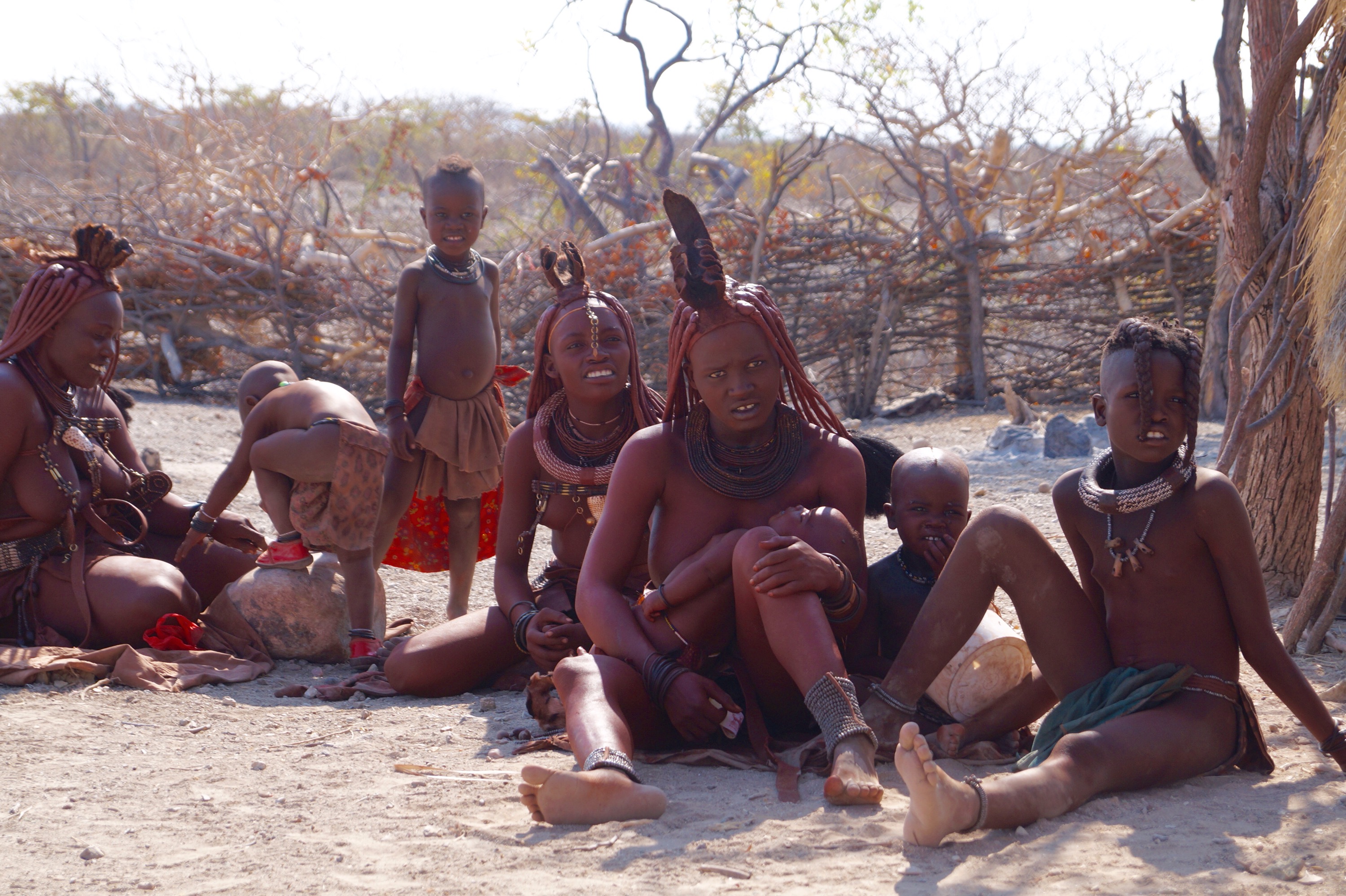
Kakoland in Northern Namibia next to the Angolan border is the traditional tribal lands of the Himba. Earlier in the week we had driven northwards from the rock art site at Twyfelfontein and stopped the night at a community campsite overlooking the Khowarib Gorge. Dotted about this part of rural Namibia are many community campsites, often set up with help from NGOs, run by local people as a way to generate income for community projects. We have stayed in several over the last few weeks, they've been all very pleasant and a good way to put money into the local economy.

In the dusty town of Opuwo we had been entranced by the variety and dress of the people coming into town. The most recognisable had been the Himba ladies. Their tall menfolk wore modern dress on the top half but kept their traditional clothes on the bottom with cloth gathered over a belt at the front; to make a double skirt effect and a different coloured cloth around their bottom. Herero ladies have distinctive Victorian style dresses made up of metres of petticoats crowding the pavements; their head scarf wraps with its unique cow horn shape. Another tribe's ladies had intricate beading in their hair and as jewellery; bare chests and coloured sarongs. It was fascinating. While Steve was stocking up for the next couple of weeks at the shops, the girls and I tried to do school in the back of the truck. We parked down a bank with the pavement at eye level, we kept on interrupting each other with another interesting sight out of the window. What the girls missed out in Maths that day they certainly made up for by what they saw outside. We spent 2 nights up on the hill at a lodge campsite overlooking the dry and dusty surrounding plains.
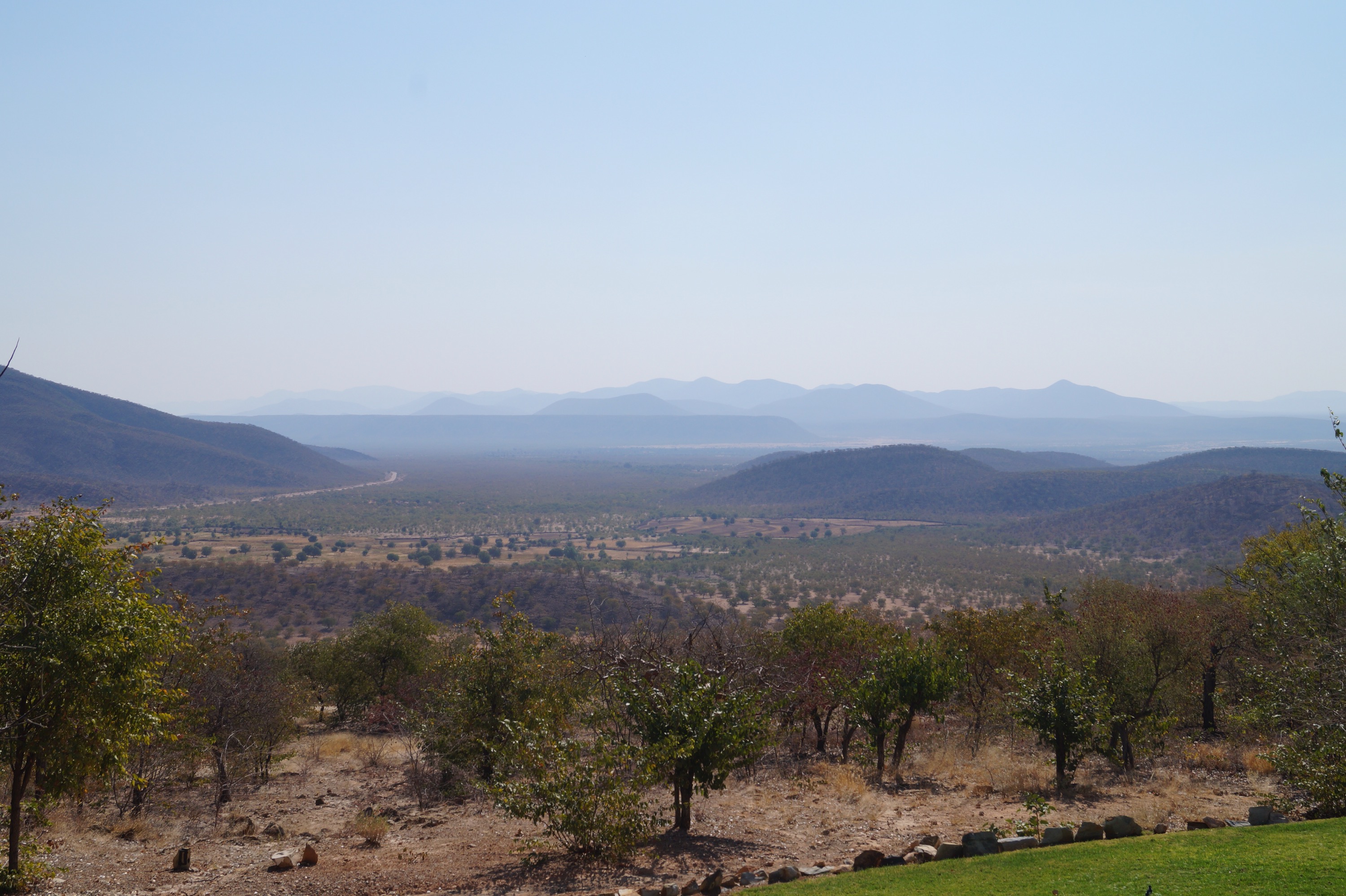
As we drove out of town and through the plains covered in low mopane trees, every so often we would see a track of a couple of tyre marks into the bush and a few cone shaped mud huts. Small herds of goats could be seen and the occasional cow but very few people. The Kunene River marks the border with Angola, the narrow strip of palm trees stood out in marked contrast with the brown, dusty surrounding hills. Epupa Falls are some of the prettiest waterfalls I've seen, the river splits into several channels and drops 60m or so into a swirling mass. Our campsite had a bar overlooking the top of the falls, as the sun set while Steve and I had a beer, the girls watched out for debris in the water. Watching any large palm leaves or logs, to see which way they would go in the waterfalls. It was like a giant version of their favourite "Pooh Sticks" game. The simple but picturesque campsite was perfectly situated under the palms shading us from the midday heat.
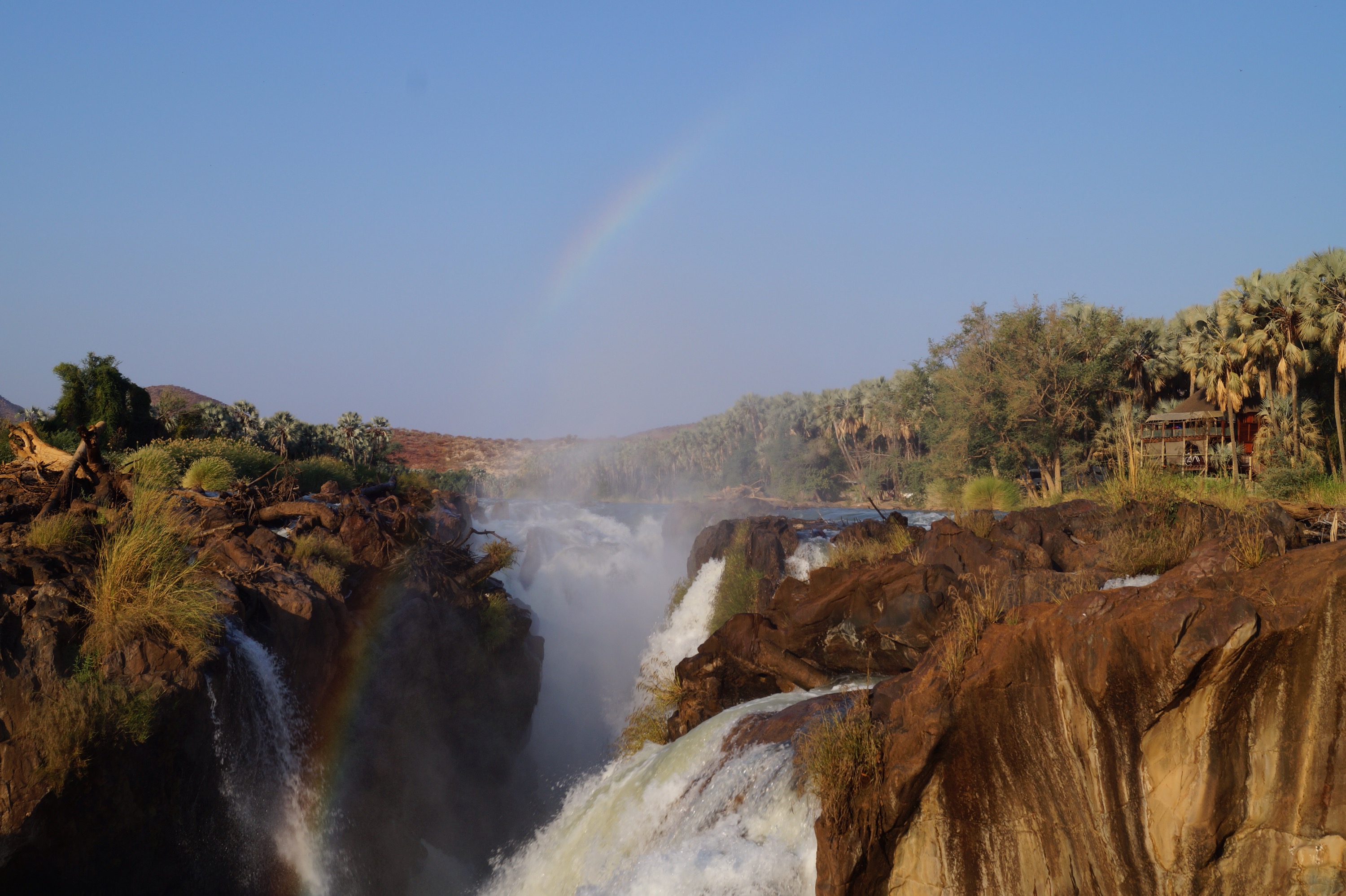
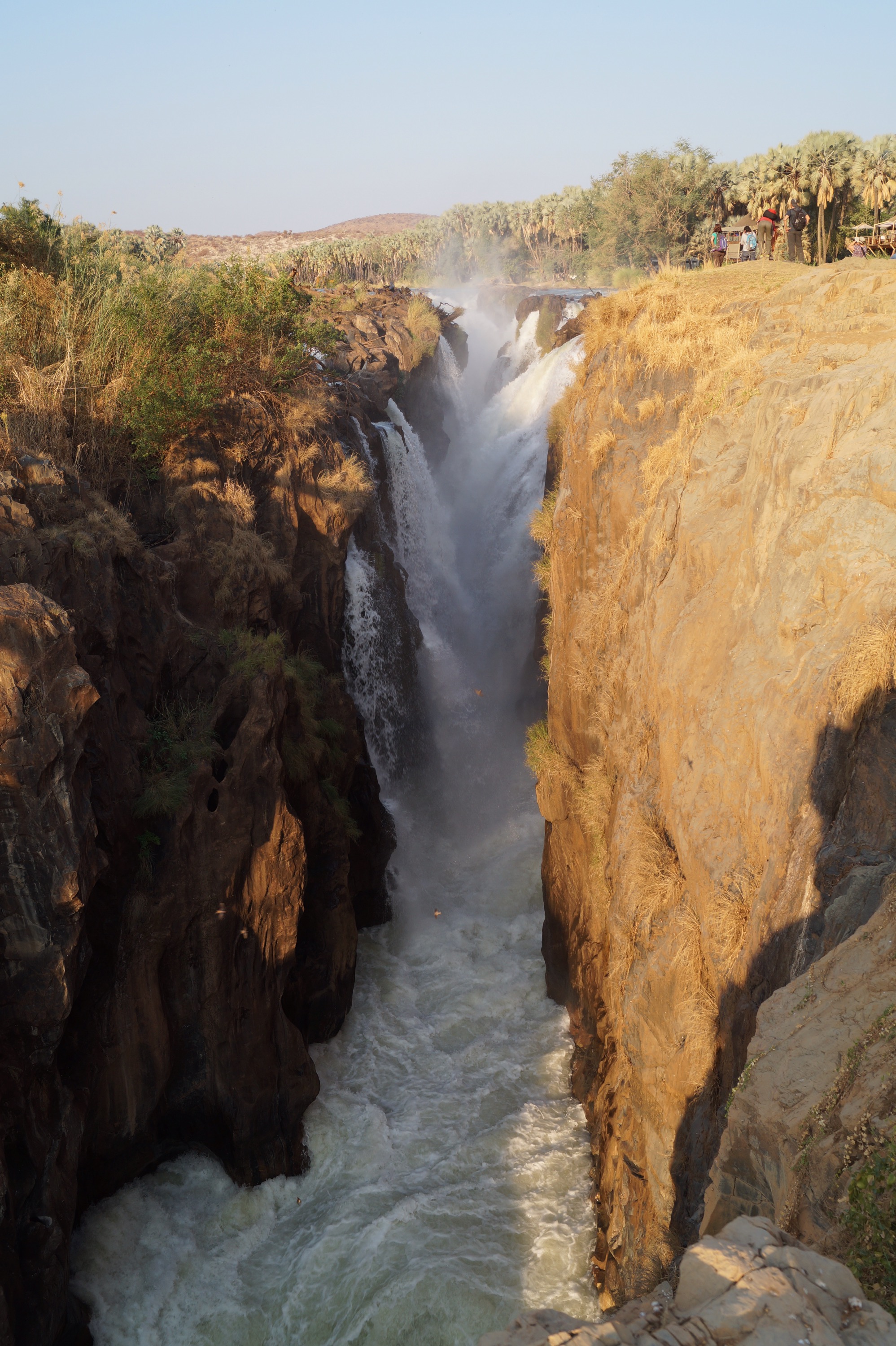
We had been repeatedly told that the road along the river was rough and with the trees would be a difficult road for a truck like ours so we backtracked 100kms to a road that would take us East along the river. At lunchtime we just pulled onto the side of the road as traffic was so rare. Two dots appeared on the horizon on the road and eventually turned into a couple of teenage boys walking to the nearby junction, to hopefully get a lift the 130kms or so to Opuwo where they went to school. Seeing us they immediately asked if we needed some help as we were parked on the side of the road, it was a humbling experience. We thanked them, gave them some water and shared some lunch before we parted in opposite directions. Further along at some roadworks we pulled in as a group of Himba ladies flagged us down. Thinking they wanted a lift on the very quiet road we stopped. I jumped down to get a old blanket from the lockers for them to sit on in the cab, as you can imagine the ochre mix is rather hard to wash out. They were all smiles, giggles and jokes. Eventually after lots of gesturing and the few words we spoke in common, it turned out they didn't want a lift but if we had any sweets that would be great, we didn't. That was absolutely fine with them, they just laughed, asked a few things we couldn't understand, joked some more and waved us goodbye.
Back at the river we had a couple of nights at a bird spotters lodge where we relaxed around the pool and enjoyed sundowners on the deck jutting out into the river. At Ruacana we had hoped to see their falls but the hydroelectric dam just upriver meant that the water level was too low. Instead all we saw was the cliff face. We found a pretty shaded community camp just below the falls for the night before heading off to spend some time in one of the highlights of Namibia.

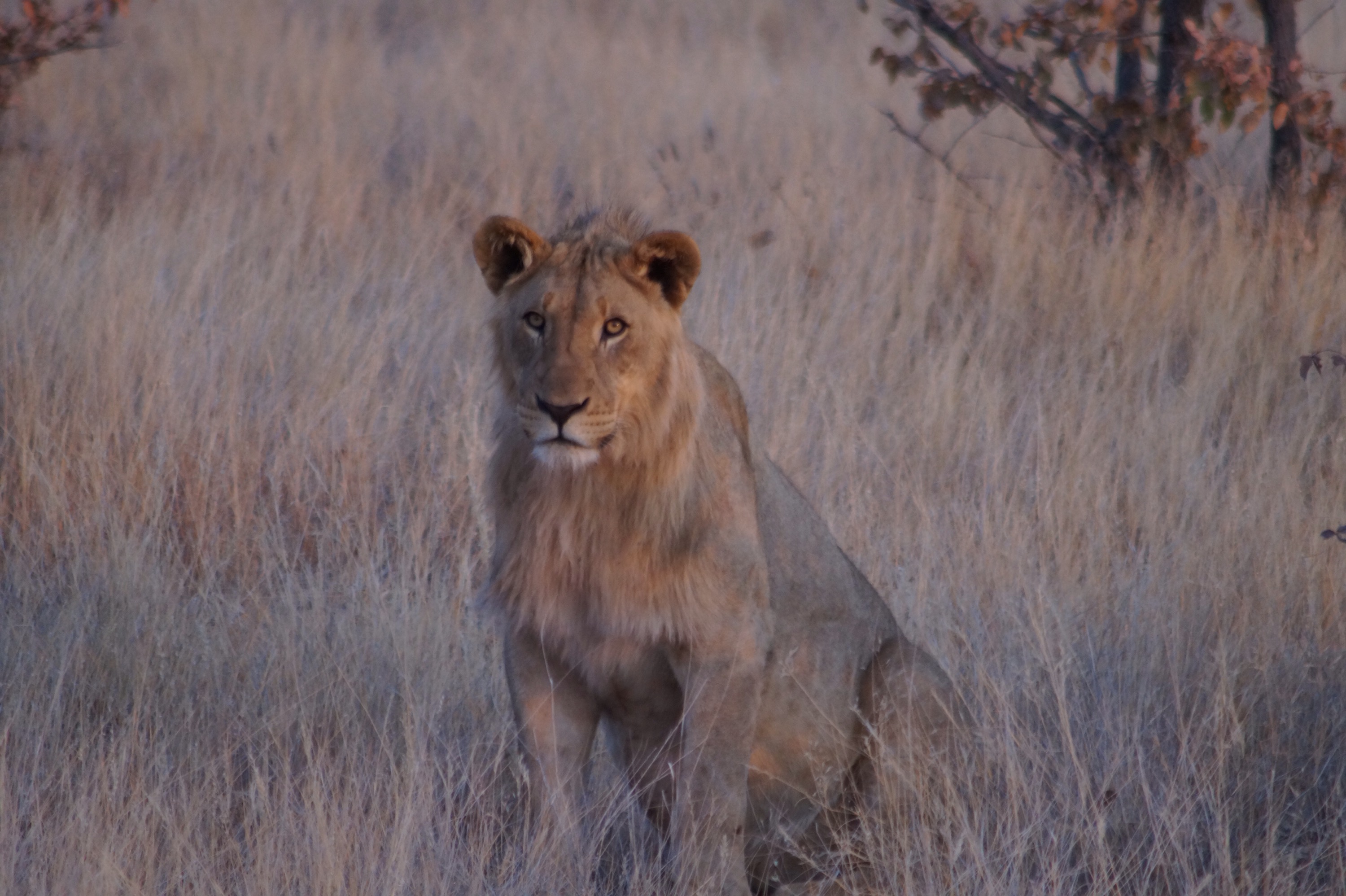
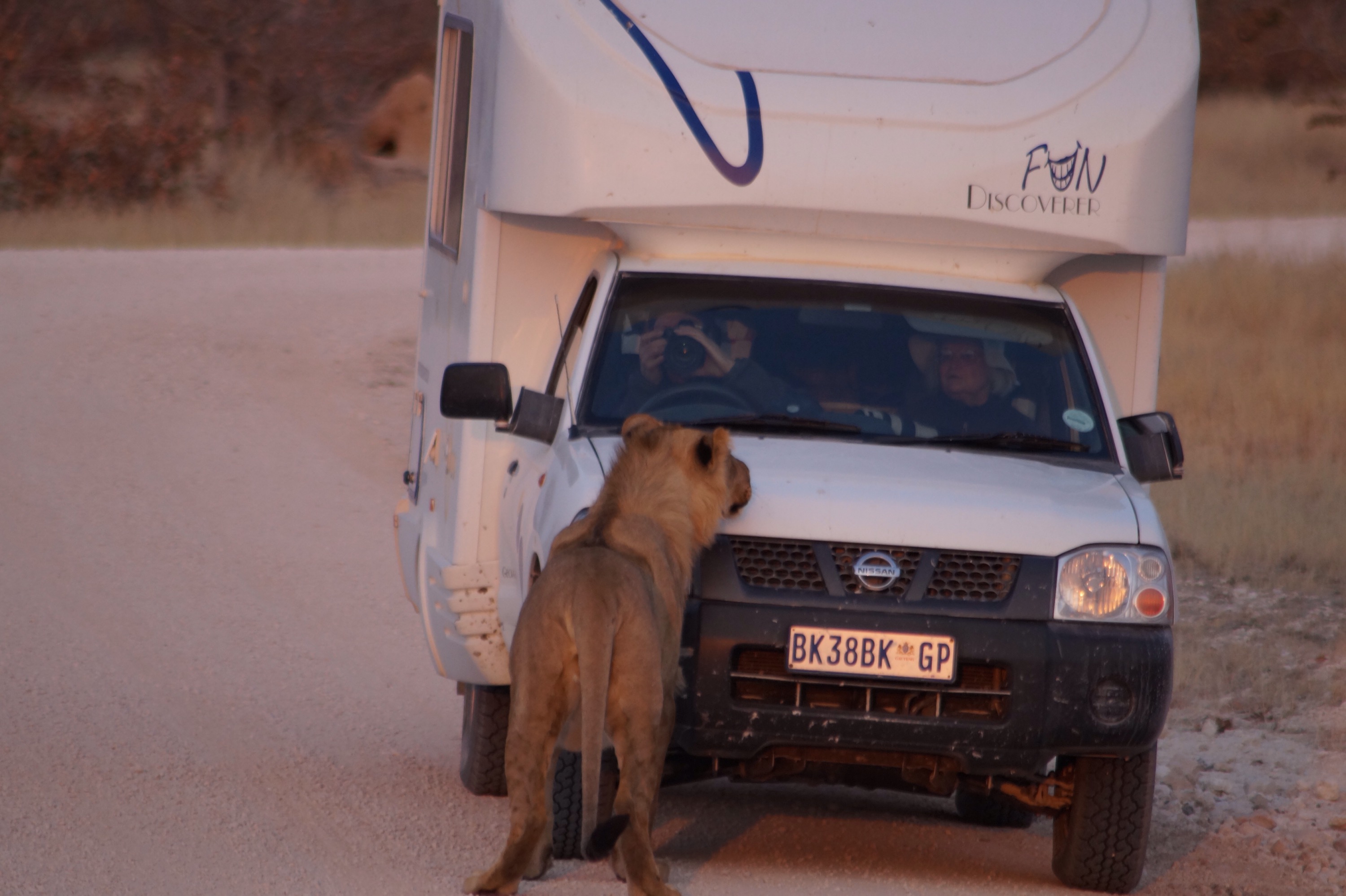 We also returned to the camp in the hope that the lions would now come down to the waterhole to drink. Most stayed some way off but one wandered down for a long drink. We were close enough to be able to hear his tongue lapping the water.
We also returned to the camp in the hope that the lions would now come down to the waterhole to drink. Most stayed some way off but one wandered down for a long drink. We were close enough to be able to hear his tongue lapping the water.
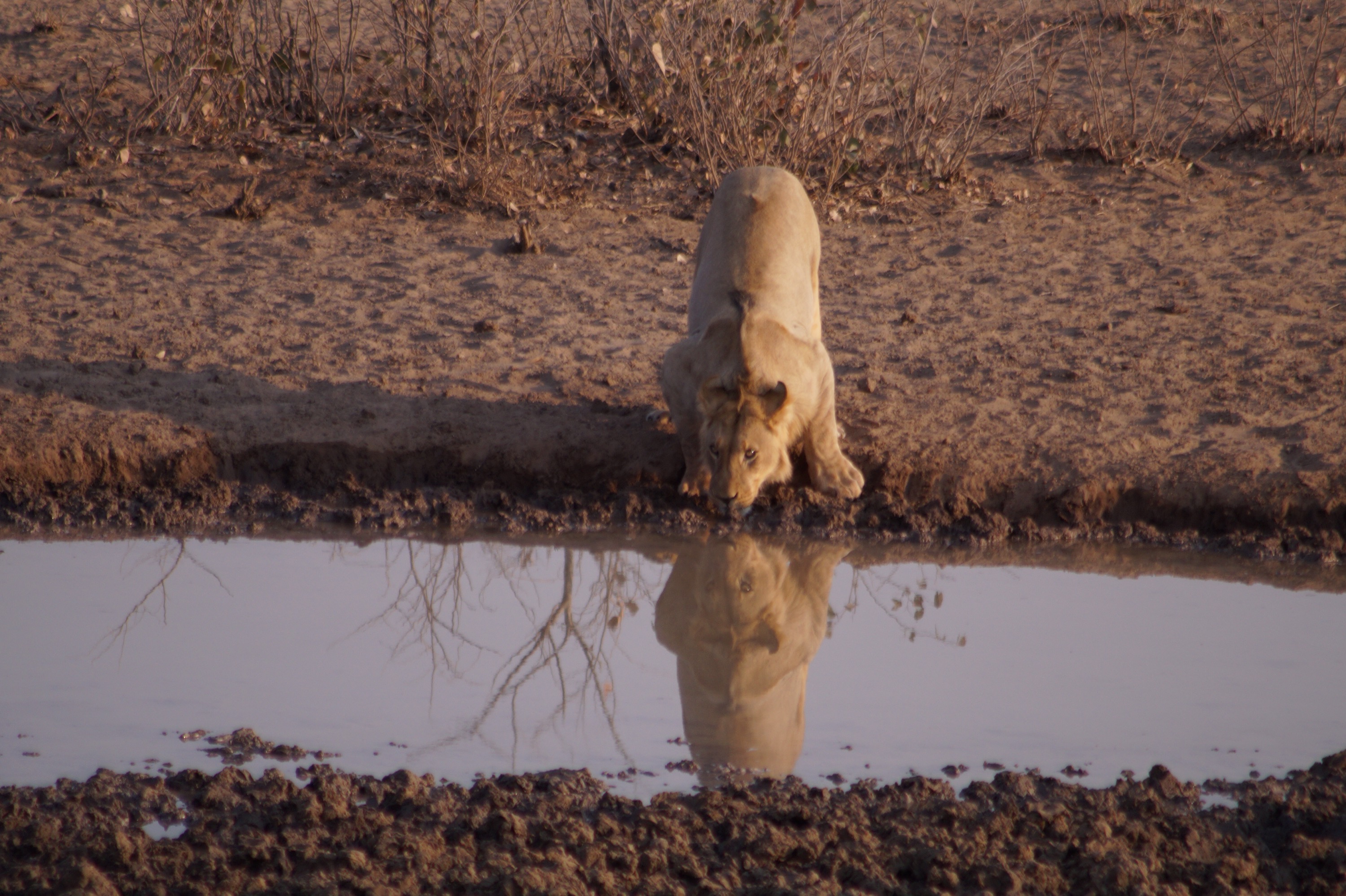 Etosha National Park is Namibia's premier wildlife park. Etosha itself is a large salt pan surrounded by dry mopane scrub, sweet grasslands (in the wet season) and a series of waterholes. It is nearly 23,000km square and is ideally suited to self driving. There is an abundance of wildlife and whilst it is easily found throughout the dry season it tends to congregate around the waterholes so we spent our time driving from waterhole to waterhole and then watching the spectacle unfold.
Having enjoyed Etosha before, we knew that as we had more time on this trip we wanted to have an extended stay and to slowly work our way across the park from West to East. However we were going to be there at peak time for tourists. We had hoped to just turn up and stay at the camps and move around as we pleased. However we were advised as we entered Namibia that many of the campsites would be fully booked. Fearing we would not be able to get anything I enquired at the office in Soussevlei whether I could book the campsites in advance. The office had just got a computer and the lady said she could book them for me. She had probably not done this for other camps before very often so I ended up sitting with her on her side of the desk and together we worked our way through her computer system. It was clear Etosha was very booked up but we managed to book 6 nights at 3 different camps. I was a little worried though about whether we had correctly done the booking as my reference number was only number 59 and she did not want me to pay for the booking saying we could just turn up.
In Swakopmund I decided to go to a much larger Parks office. Luckily the lady there said we did have reservations although she was surprised at how the booking had been done. She did say though we should have paid for them by now. So before they were cancelled we paid and together with booking some additional nights on the Internet we had in total 9 nights booked.
We entered the park at the Western Gate and were surprised at the amount of the wildlife at the first few waterholes. Impala, Kudu, Gemsbok, Zebra, Springbok and Giraffes were everywhere but the stars of the show were the Elephants coming down to drink and bathe. They were so entertaining to watch especially the breeding herds with young. They would drink, throw water all over themselves, the. Have a dust bath and finally go for a good old scratch on a nearby termite mound.
Etosha National Park is Namibia's premier wildlife park. Etosha itself is a large salt pan surrounded by dry mopane scrub, sweet grasslands (in the wet season) and a series of waterholes. It is nearly 23,000km square and is ideally suited to self driving. There is an abundance of wildlife and whilst it is easily found throughout the dry season it tends to congregate around the waterholes so we spent our time driving from waterhole to waterhole and then watching the spectacle unfold.
Having enjoyed Etosha before, we knew that as we had more time on this trip we wanted to have an extended stay and to slowly work our way across the park from West to East. However we were going to be there at peak time for tourists. We had hoped to just turn up and stay at the camps and move around as we pleased. However we were advised as we entered Namibia that many of the campsites would be fully booked. Fearing we would not be able to get anything I enquired at the office in Soussevlei whether I could book the campsites in advance. The office had just got a computer and the lady said she could book them for me. She had probably not done this for other camps before very often so I ended up sitting with her on her side of the desk and together we worked our way through her computer system. It was clear Etosha was very booked up but we managed to book 6 nights at 3 different camps. I was a little worried though about whether we had correctly done the booking as my reference number was only number 59 and she did not want me to pay for the booking saying we could just turn up.
In Swakopmund I decided to go to a much larger Parks office. Luckily the lady there said we did have reservations although she was surprised at how the booking had been done. She did say though we should have paid for them by now. So before they were cancelled we paid and together with booking some additional nights on the Internet we had in total 9 nights booked.
We entered the park at the Western Gate and were surprised at the amount of the wildlife at the first few waterholes. Impala, Kudu, Gemsbok, Zebra, Springbok and Giraffes were everywhere but the stars of the show were the Elephants coming down to drink and bathe. They were so entertaining to watch especially the breeding herds with young. They would drink, throw water all over themselves, the. Have a dust bath and finally go for a good old scratch on a nearby termite mound.
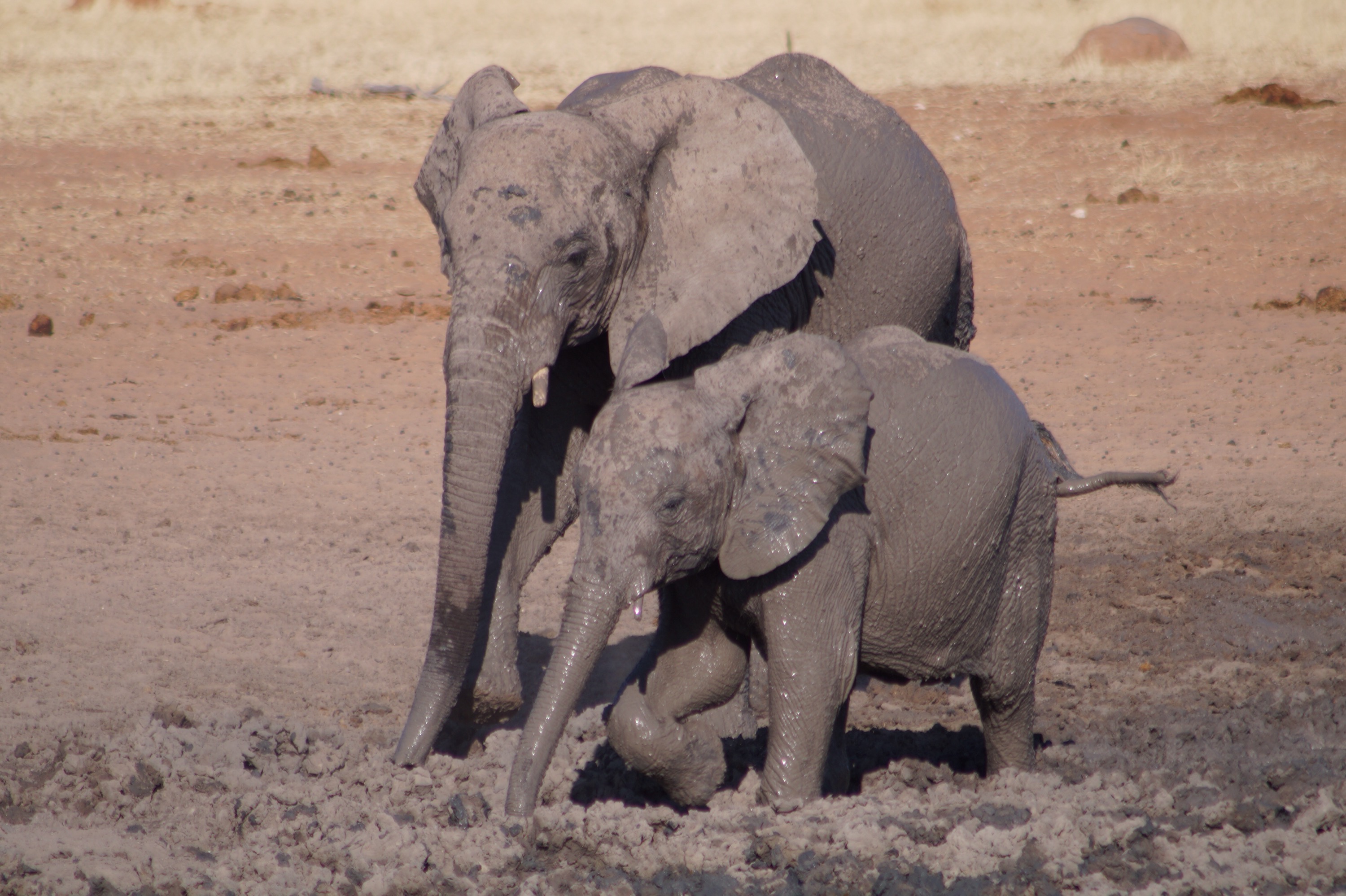
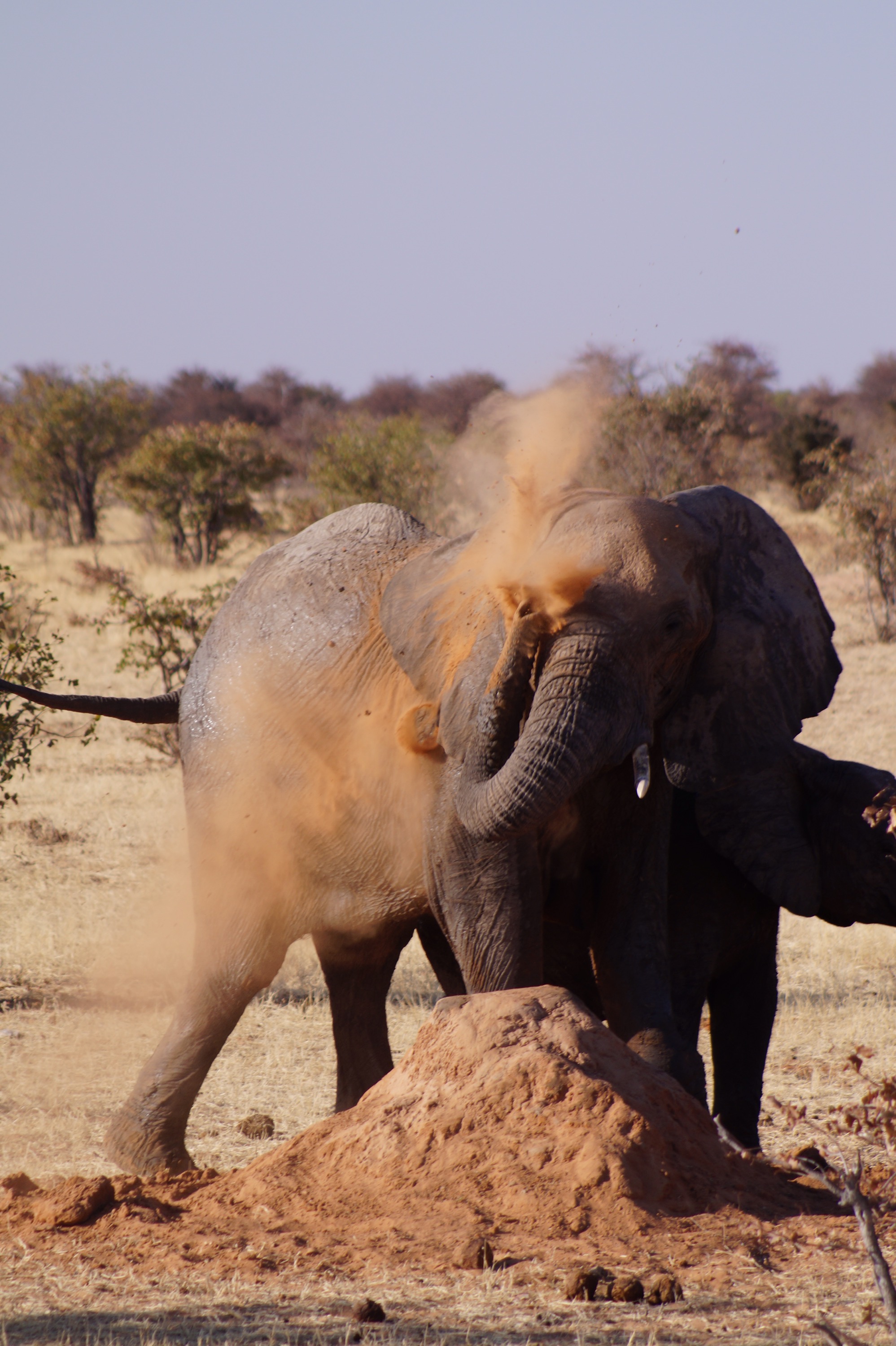
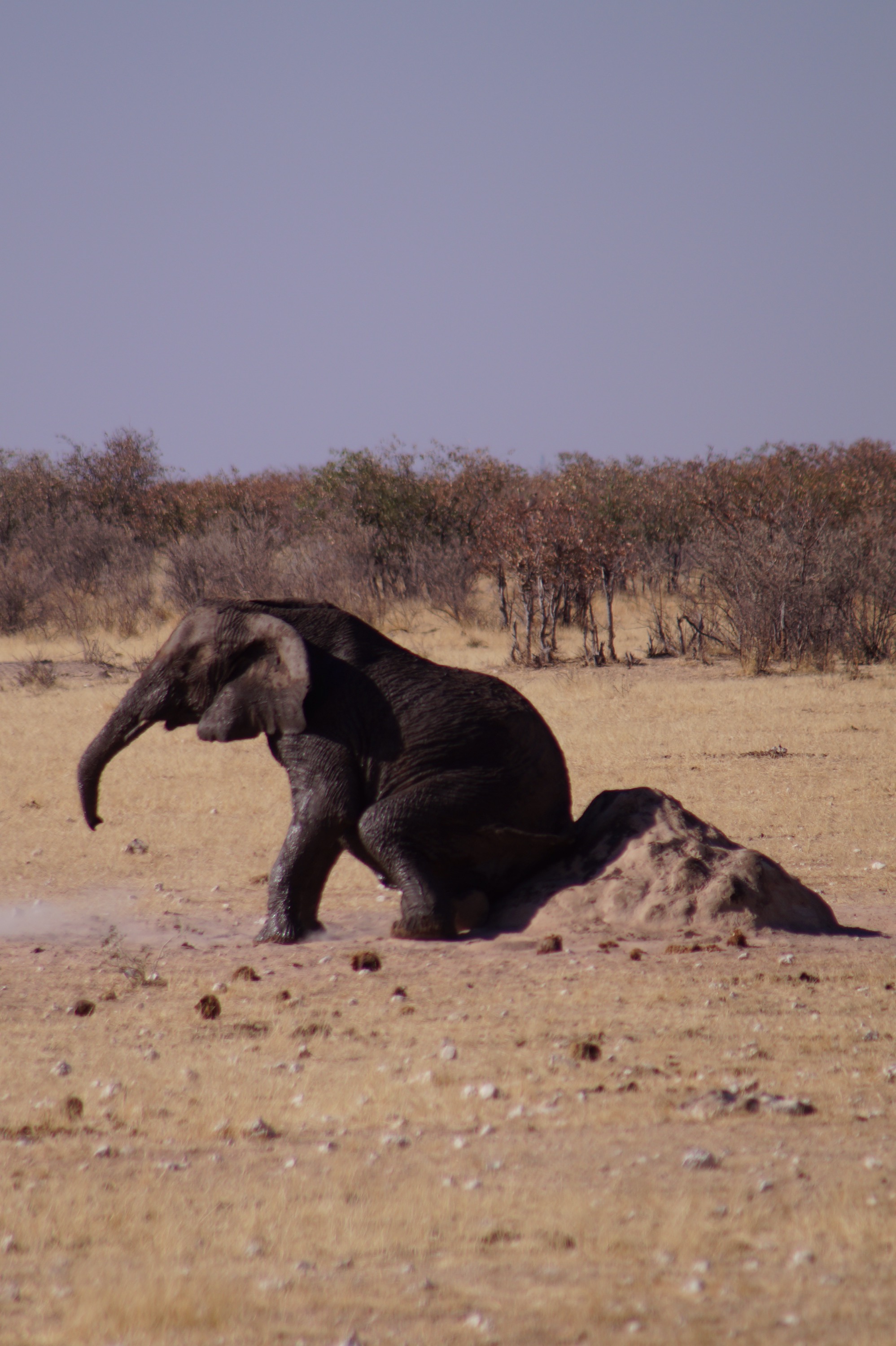
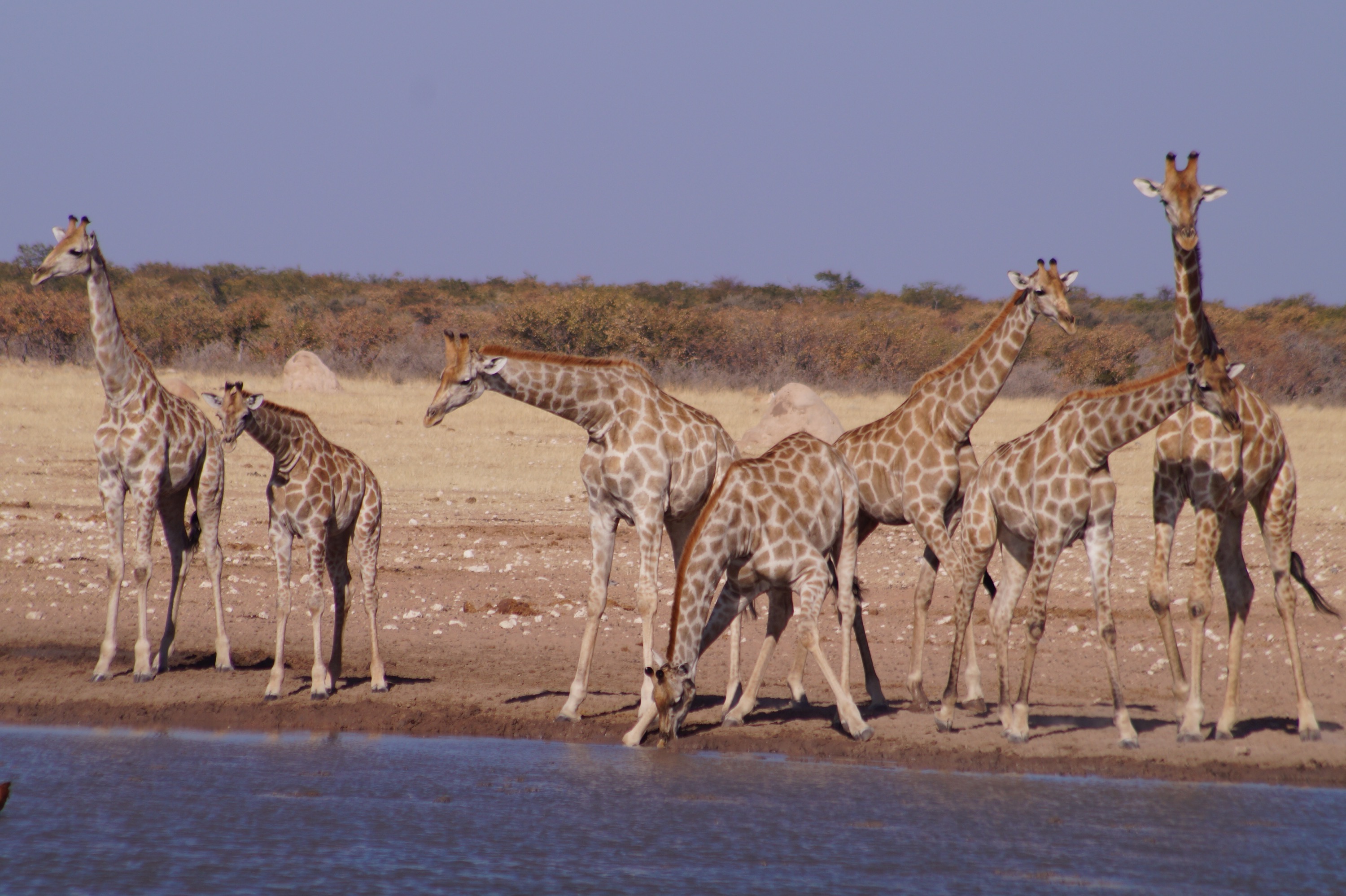

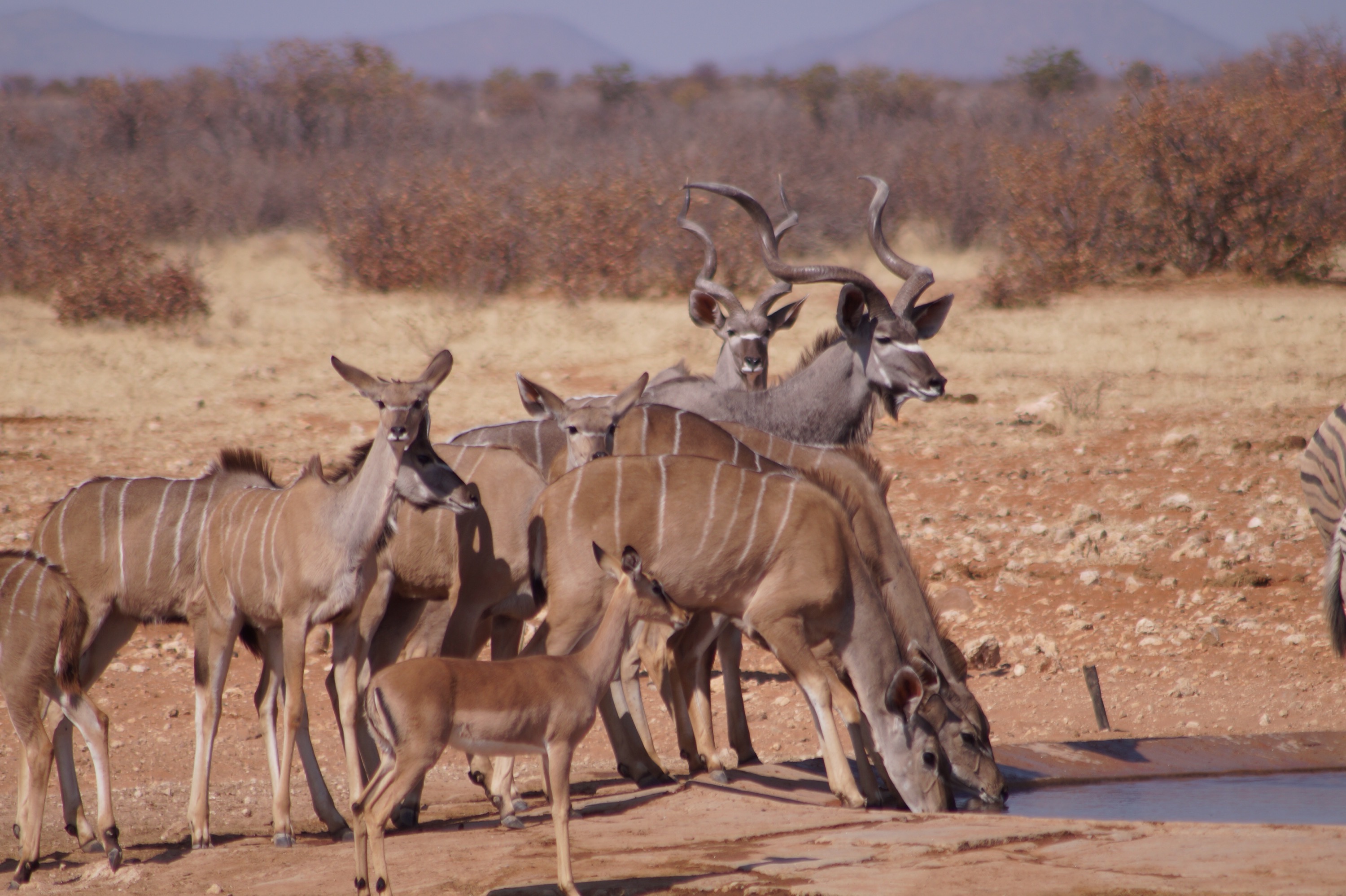 Our first camp was at Olifantsrus, a new camp that did not have any chalets and was therefore small, and in our view, the nicest of the 4 camps. At each of the camps game viewing did not stop when the sun went down as you were able to sit overlooking floodlit waterholes. During our evenings viewing we saw various game but the most impressive was the amount of black rhino we saw. On one evening we saw at least six. Black rhino are very rare and difficult to see so Etosha must be about the best place in the world to see them. Not that everything was always peaceful around the waterhole. The elephants would often chase away the other animals, the rhino would chase each other, the elephants and vice versa and when the hyenas came down to drink they would chase and be chased.
Our first camp was at Olifantsrus, a new camp that did not have any chalets and was therefore small, and in our view, the nicest of the 4 camps. At each of the camps game viewing did not stop when the sun went down as you were able to sit overlooking floodlit waterholes. During our evenings viewing we saw various game but the most impressive was the amount of black rhino we saw. On one evening we saw at least six. Black rhino are very rare and difficult to see so Etosha must be about the best place in the world to see them. Not that everything was always peaceful around the waterhole. The elephants would often chase away the other animals, the rhino would chase each other, the elephants and vice versa and when the hyenas came down to drink they would chase and be chased.
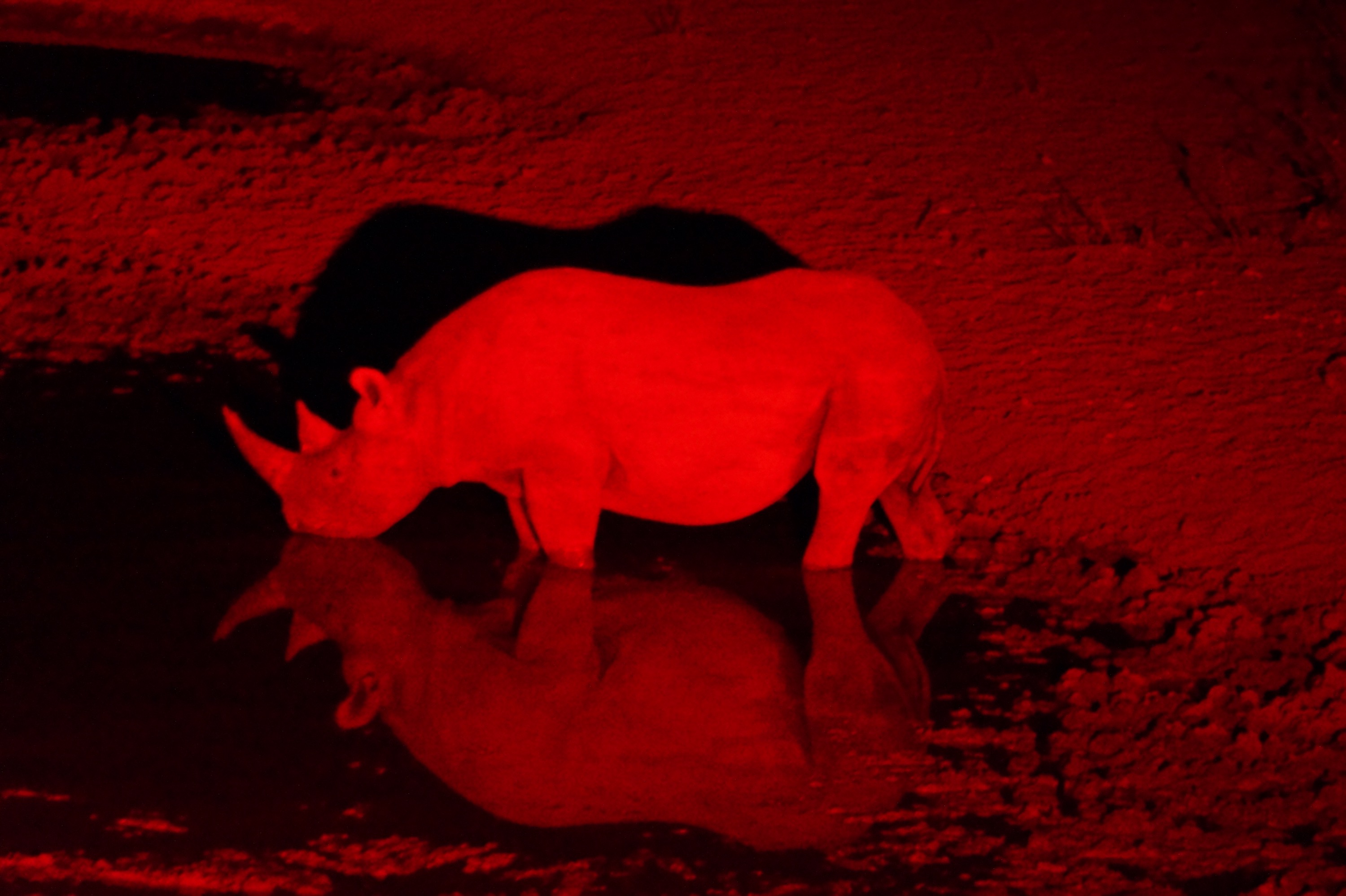

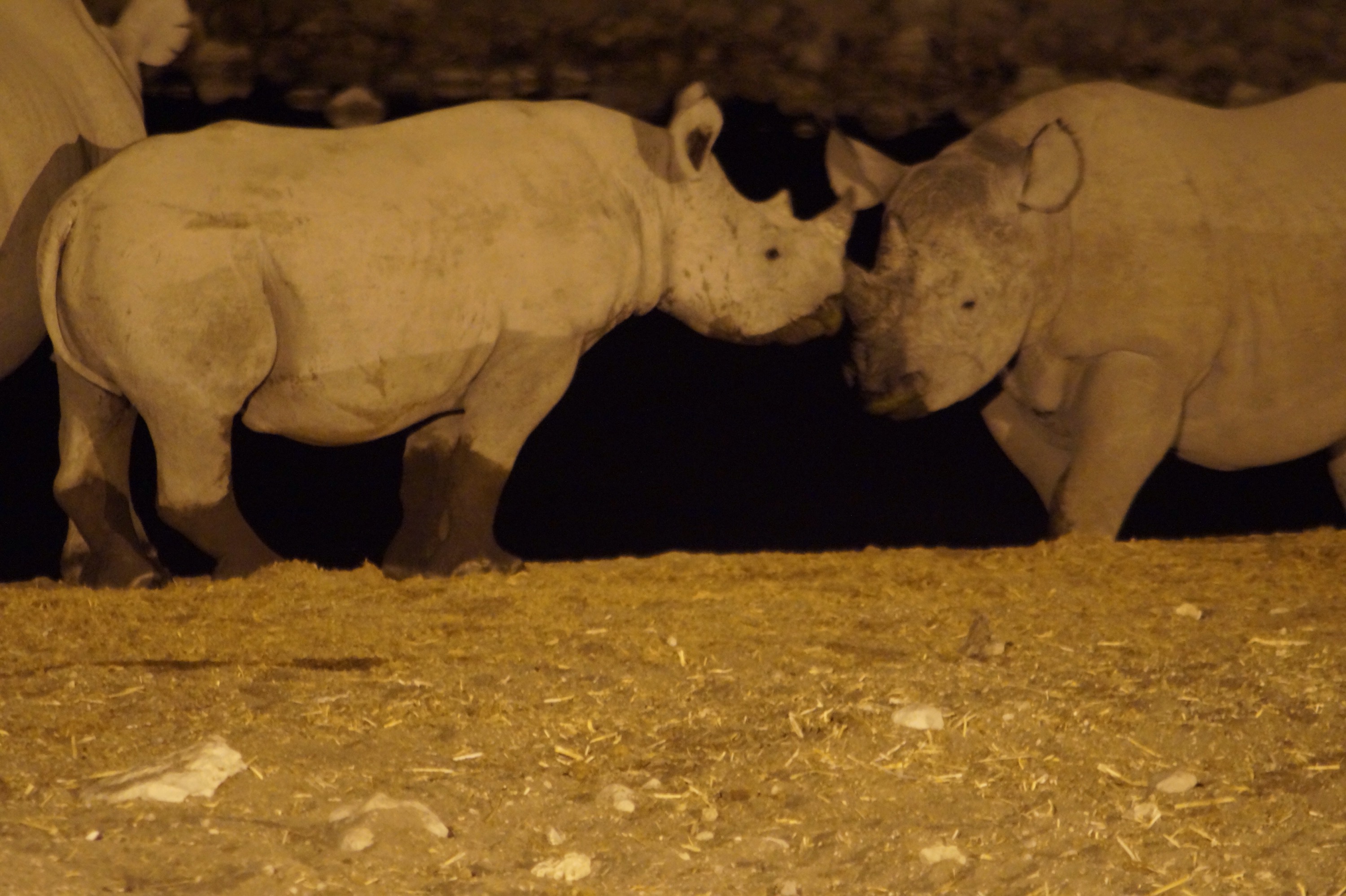 Watching the animals at the waterhole was like watching a play been acted out on stage. We spent many hours at the waterhole at Halali campsite and saw lots of things. But this was not a play put on for the benefit of the guests but real life in the animal world. This was brought home to us on the second day we were there. We had watched early that afternoon the elephants playing in the pool. When we returned later that evening one of the younger elephants lay dead in the middle of the pool. We learnt it had become stuck in the mud and drowned in its efforts to escape. The next morning the Rangers removed it from the water to stop it from polluting the pool when it rotted. Everyone was looking forward to the carcass been found by hyenas or lions and to see the spectacle unfold right in front of the viewing area but later that day the Rangers brought in a big grader and dragged the elephant carcass further into the bush almost out of sight. This meant that when the lions came to feed on it the next day we could only catch glimpses of them in the grass.
Watching the animals at the waterhole was like watching a play been acted out on stage. We spent many hours at the waterhole at Halali campsite and saw lots of things. But this was not a play put on for the benefit of the guests but real life in the animal world. This was brought home to us on the second day we were there. We had watched early that afternoon the elephants playing in the pool. When we returned later that evening one of the younger elephants lay dead in the middle of the pool. We learnt it had become stuck in the mud and drowned in its efforts to escape. The next morning the Rangers removed it from the water to stop it from polluting the pool when it rotted. Everyone was looking forward to the carcass been found by hyenas or lions and to see the spectacle unfold right in front of the viewing area but later that day the Rangers brought in a big grader and dragged the elephant carcass further into the bush almost out of sight. This meant that when the lions came to feed on it the next day we could only catch glimpses of them in the grass.
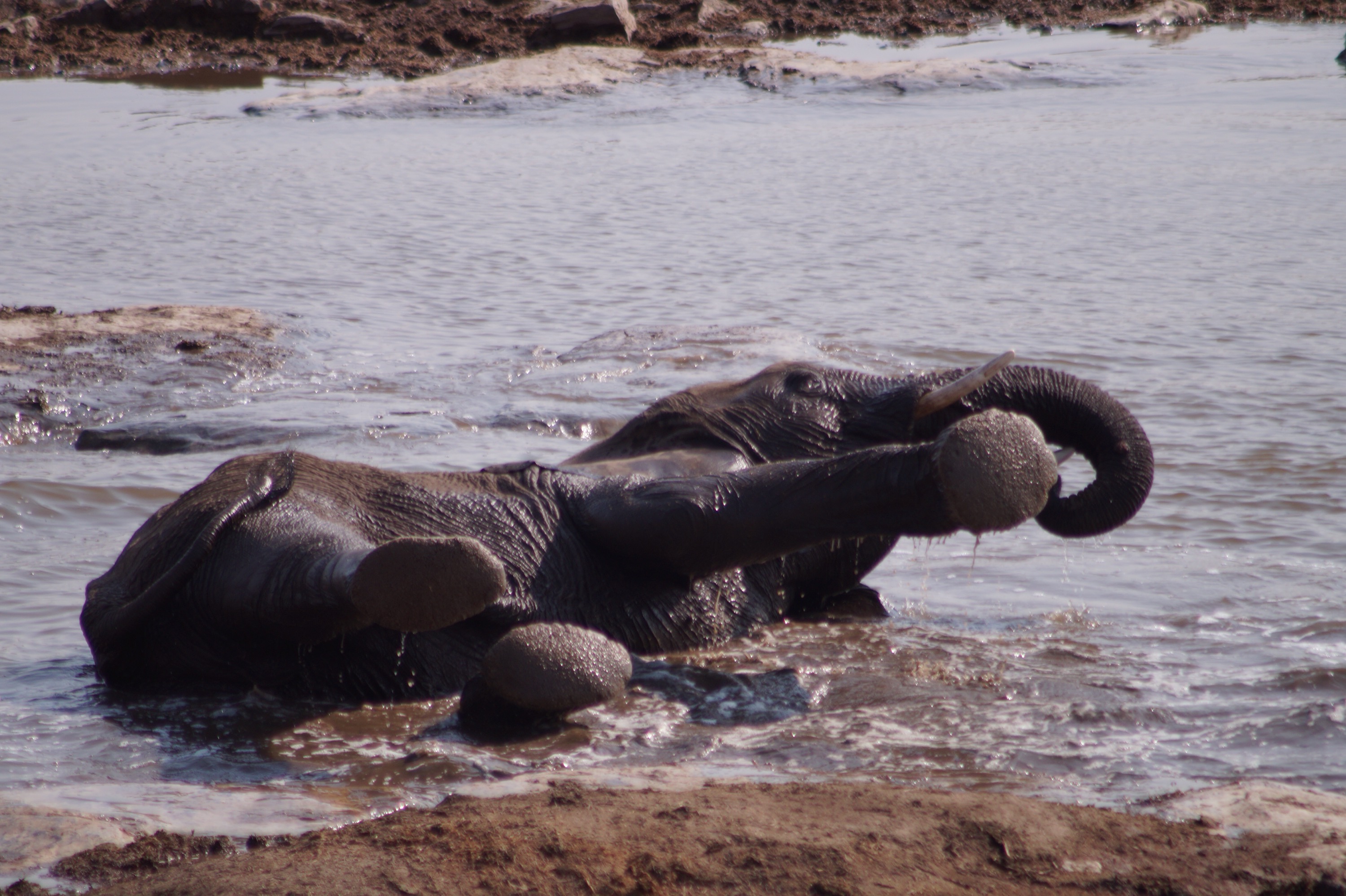
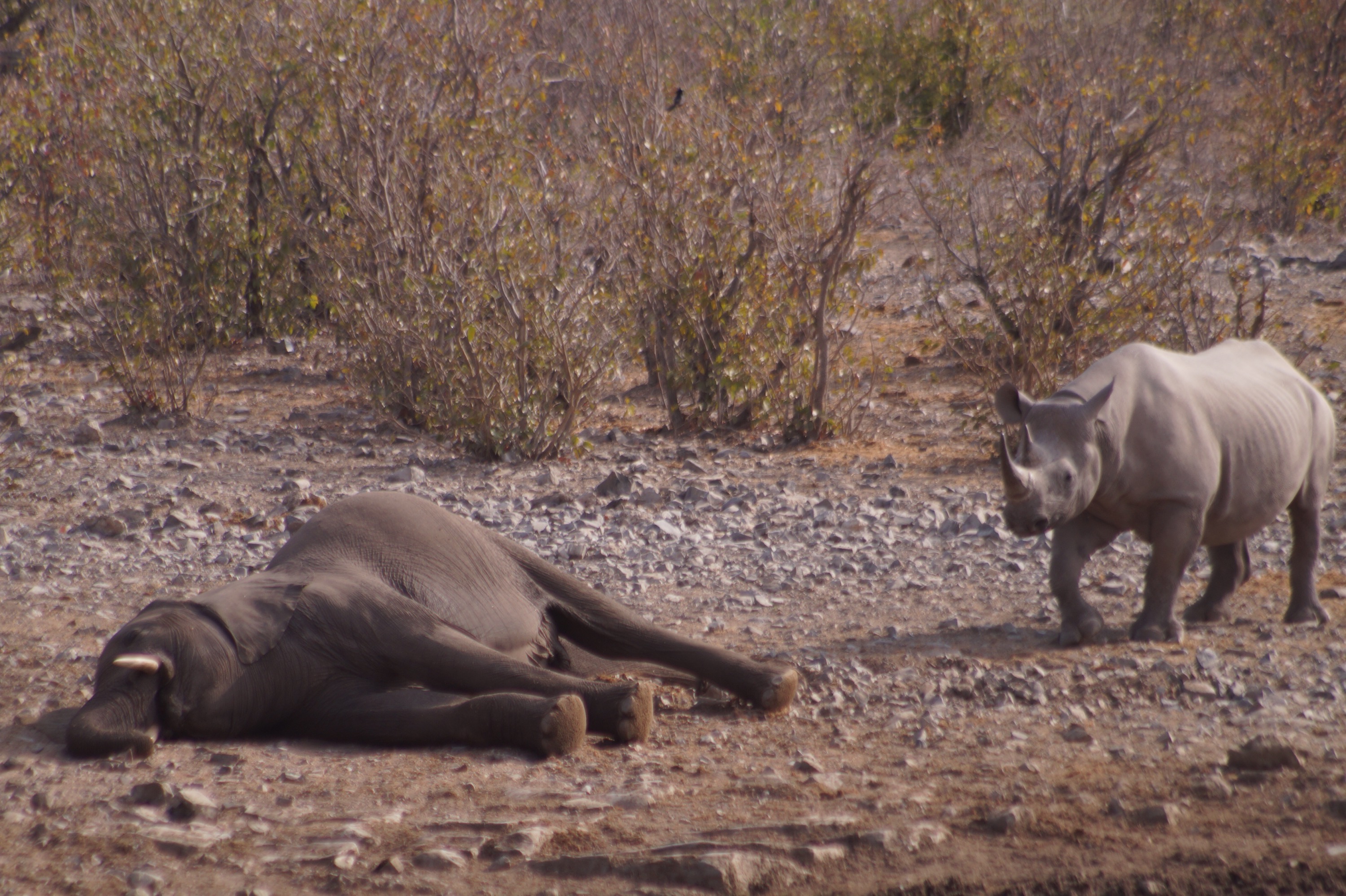
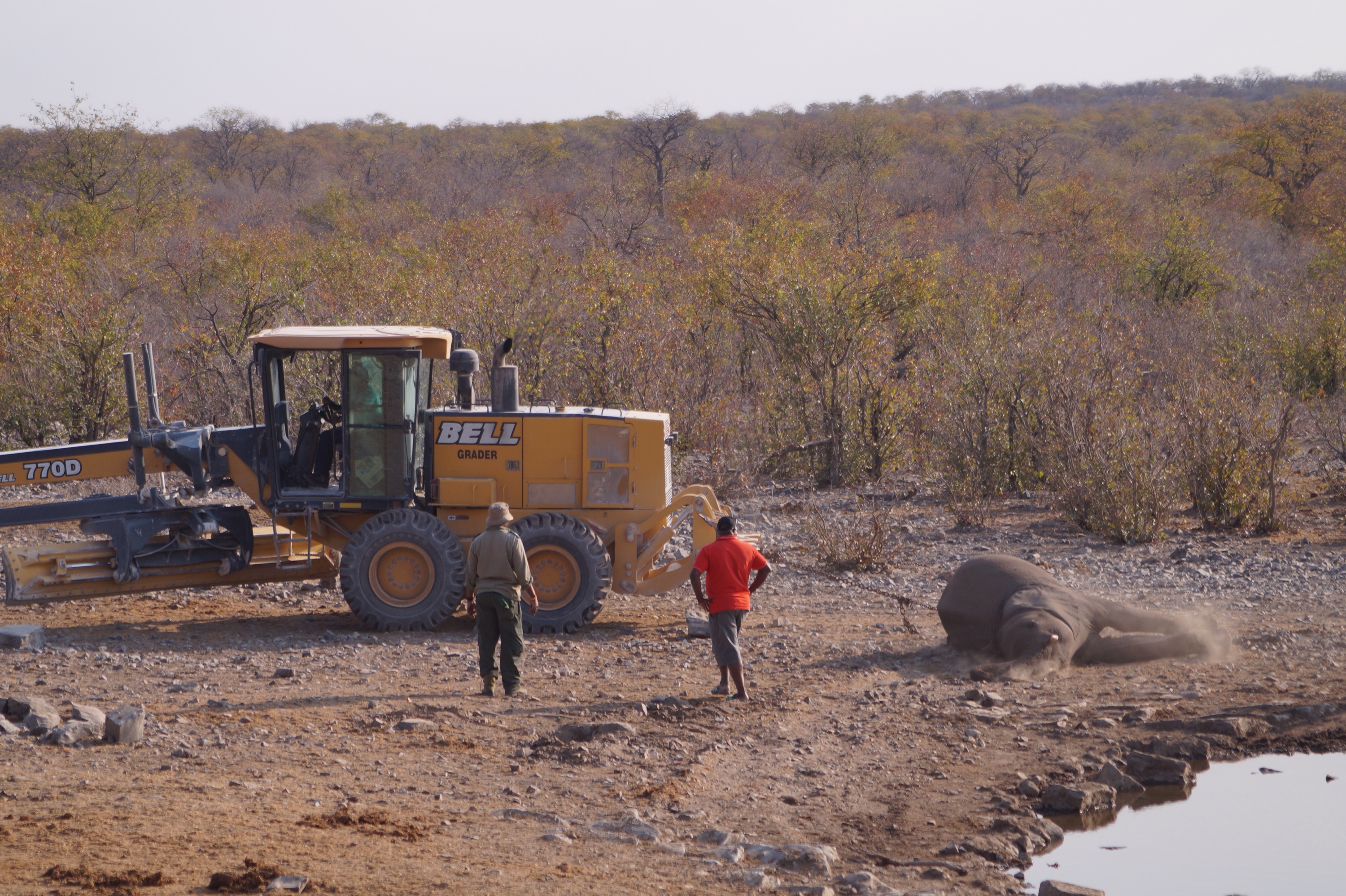
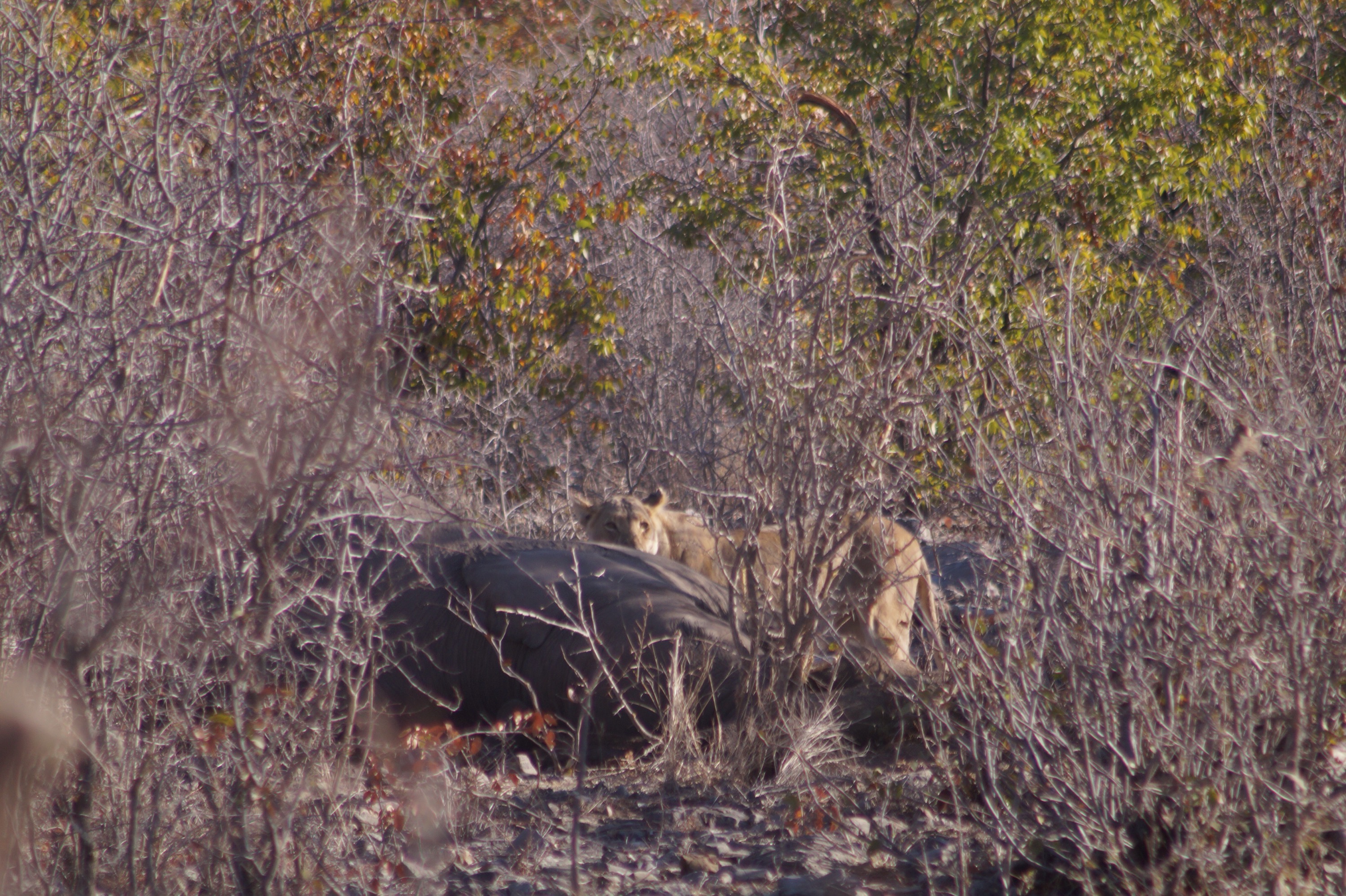 While we missed the elephant drama at Halali we had our own waterhole drama while out on our late afternoon game drive. We were watching elephant in the waterhole but could see some other vehicles staring into the bush. We drove round to investigate but could not see anything. We moved away to watch the elephants again and a few minutes later a large male lion walked across the ground to the waterhole. The animals can really blend into the landscape so spotting them is not that easy especially when they are laid up for the day. We watched him drink for a while and then needed to leave to get back to camp before the gates closed. As we pulled back on the track there was a large male elephant in the way. The advice of experts is to stop, stay calm and, if you dare, switch off your engine. Been in a 10 tonne truck I felt much more confident than if I had been in a car so I switched off the engine. The elephant kept coming towards us. I said to Gilly don't worry, it will see we are bigger than it and move away. It didn't and kept coming closer and closer and as we all held our breath passed just inches from our wing mirror.
While we missed the elephant drama at Halali we had our own waterhole drama while out on our late afternoon game drive. We were watching elephant in the waterhole but could see some other vehicles staring into the bush. We drove round to investigate but could not see anything. We moved away to watch the elephants again and a few minutes later a large male lion walked across the ground to the waterhole. The animals can really blend into the landscape so spotting them is not that easy especially when they are laid up for the day. We watched him drink for a while and then needed to leave to get back to camp before the gates closed. As we pulled back on the track there was a large male elephant in the way. The advice of experts is to stop, stay calm and, if you dare, switch off your engine. Been in a 10 tonne truck I felt much more confident than if I had been in a car so I switched off the engine. The elephant kept coming towards us. I said to Gilly don't worry, it will see we are bigger than it and move away. It didn't and kept coming closer and closer and as we all held our breath passed just inches from our wing mirror.
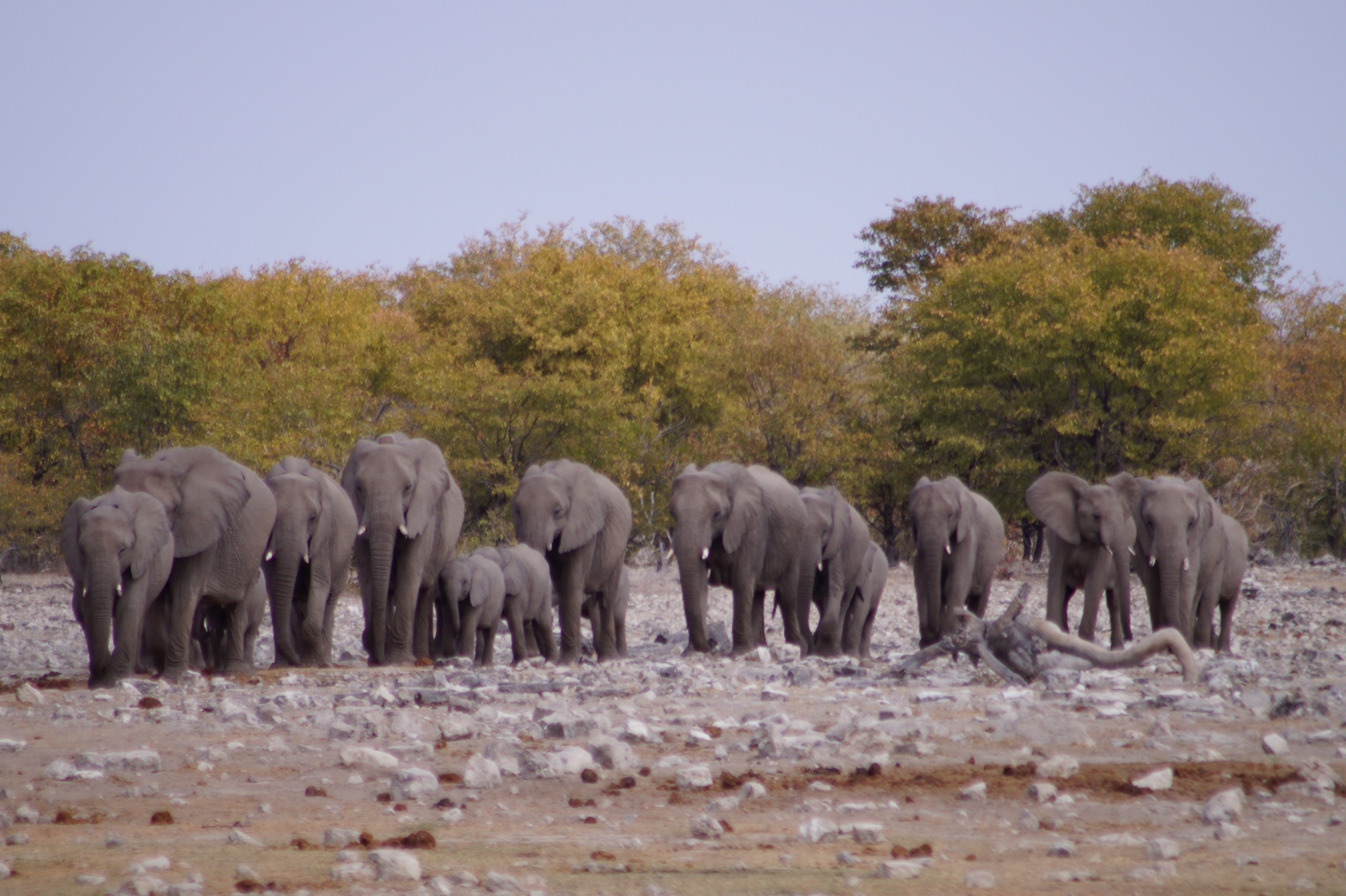

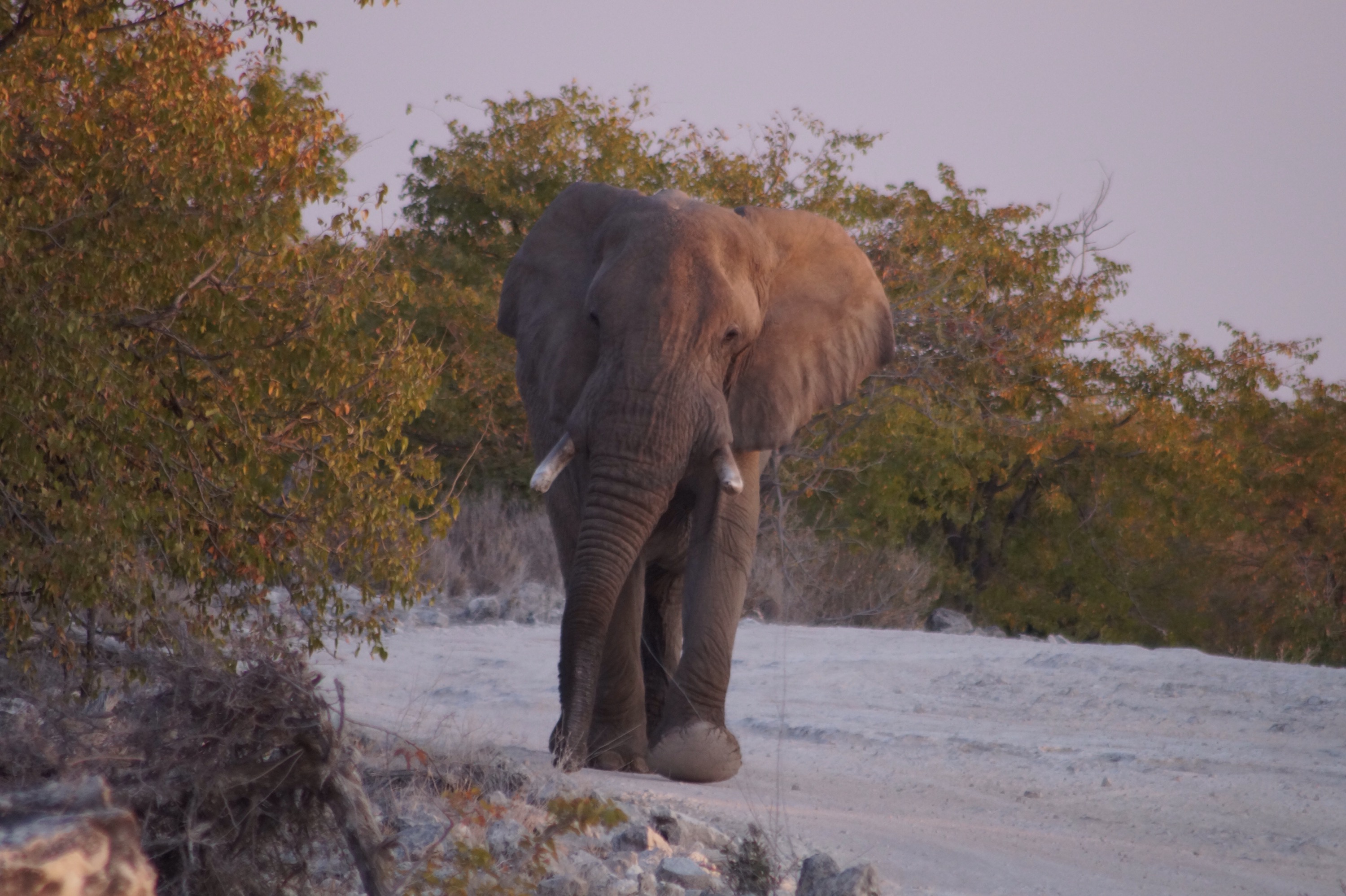
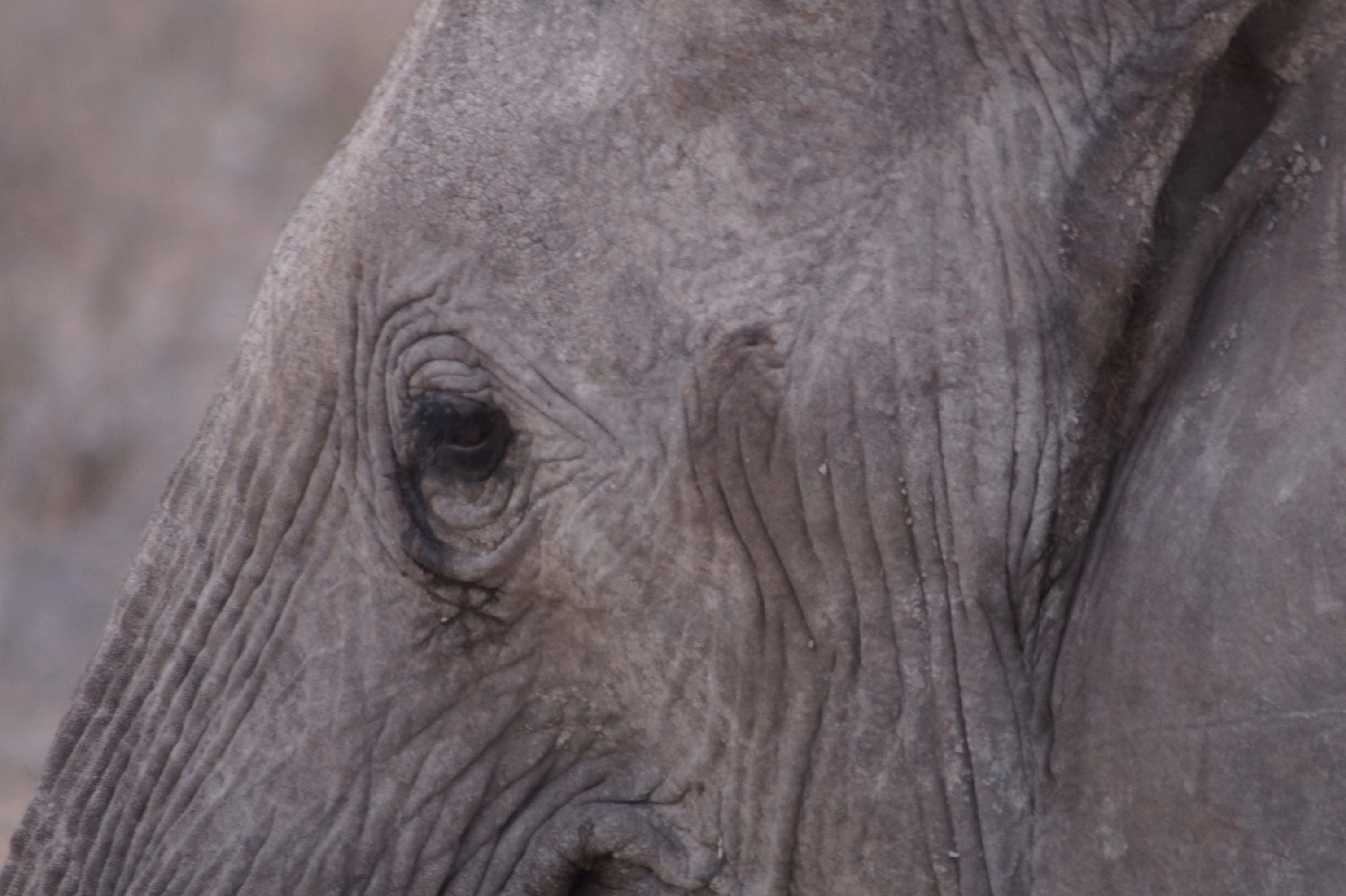 The campsites each have their own particular features. One of them Namutoni is even built around an old German fort that was built at the beginning of the 1900's. They also each had there own set of animals that broke into the campground at night. At Okakuejo and Namutoni these were jackels looking for scraps. But at Halali it was something different. Gilly and the kids had been hoping we would see a honey badger in the park after reading that they were one of Africa's most fearsome creatures, and that morning we had spotted one in the bush. It was some way off though so was only a little dot in our pictures. Not that we needed to have worried. That night honey badgers turned up at camp and were not afraid at all. As they have a fearsome bite it was us that were getting out of their way as they roamed the campsite in search of food.
The campsites each have their own particular features. One of them Namutoni is even built around an old German fort that was built at the beginning of the 1900's. They also each had there own set of animals that broke into the campground at night. At Okakuejo and Namutoni these were jackels looking for scraps. But at Halali it was something different. Gilly and the kids had been hoping we would see a honey badger in the park after reading that they were one of Africa's most fearsome creatures, and that morning we had spotted one in the bush. It was some way off though so was only a little dot in our pictures. Not that we needed to have worried. That night honey badgers turned up at camp and were not afraid at all. As they have a fearsome bite it was us that were getting out of their way as they roamed the campsite in search of food.
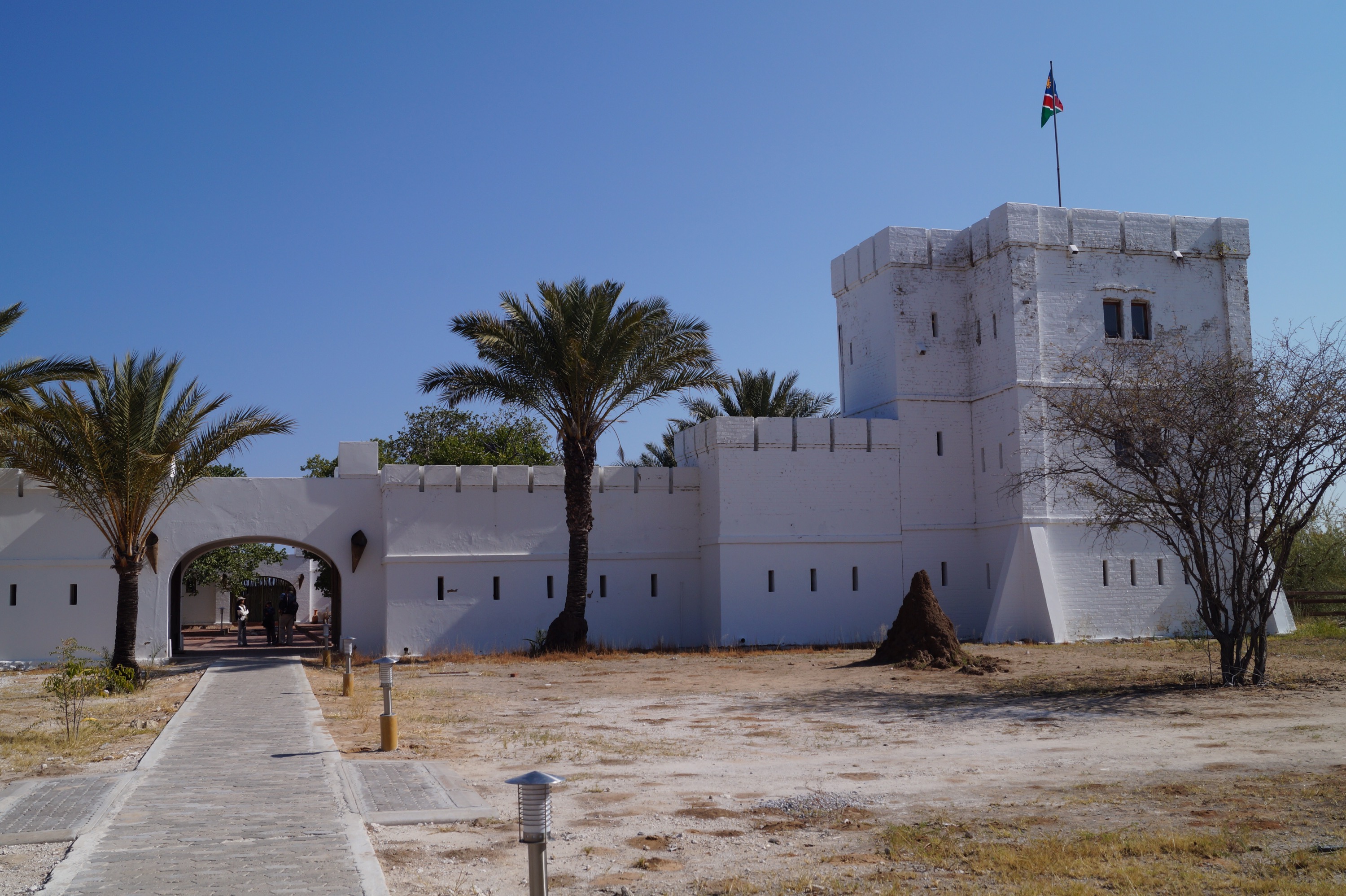
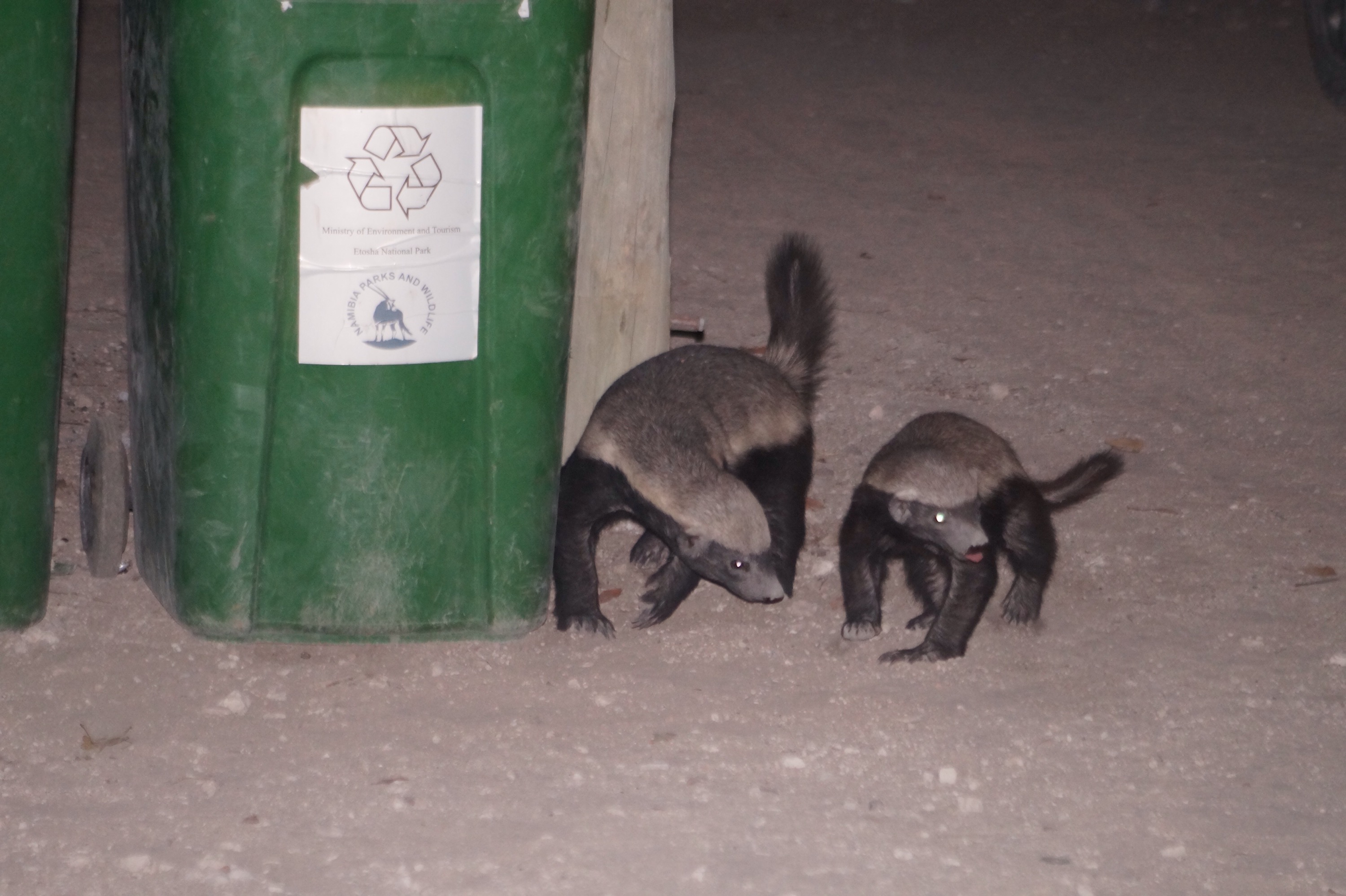 Whilst sometimes it was easy to spot game, such as watching 60 plus elephants at a waterhole, other times we would drive for ages looking for it especially trying to find big cats which were more elusive. We especially wanted to see leopard. One morning we rounded a corner and Gilly shouted "Leopard". And there it was, but it was heading away from us fast. It stopped briefly to look back at us and we could see it clearly in the binoculars. We felt really lucky to have glimpsed it but disappointed we could not get a photo. Five minutes later I shouted "lion". There was a female lion with 2 large cubs lying in the grass. They were some way away but we decided to wait. After an hour they got up to try and find a more shaded spot. Luckily for us this time we were in their path and they passed close to the truck.
Whilst sometimes it was easy to spot game, such as watching 60 plus elephants at a waterhole, other times we would drive for ages looking for it especially trying to find big cats which were more elusive. We especially wanted to see leopard. One morning we rounded a corner and Gilly shouted "Leopard". And there it was, but it was heading away from us fast. It stopped briefly to look back at us and we could see it clearly in the binoculars. We felt really lucky to have glimpsed it but disappointed we could not get a photo. Five minutes later I shouted "lion". There was a female lion with 2 large cubs lying in the grass. They were some way away but we decided to wait. After an hour they got up to try and find a more shaded spot. Luckily for us this time we were in their path and they passed close to the truck.

 A couple of mornings later we returned to the same track. We did not really expect to find the leopard and lions again but you never know. We could see a car had stopped on the track ahead and slowed down. A lone springbok was standing alert looking towards us. Following its gaze, Gilly said "Look there's a springbok kill". As we looked at it we realised a leopard was right next to it, it must have killed the springbok only moments before. We watched as the leopard slowly dragged the carcass away from the road into cover. It took it a while as the male springbok must have weighed more than the leopard. Now we felt really lucky as after watching it for a few minutes it disappeared into the bush. If we had been a few minutes later we would have missed it. Now if only we had been a few minutes earlier!
A couple of mornings later we returned to the same track. We did not really expect to find the leopard and lions again but you never know. We could see a car had stopped on the track ahead and slowed down. A lone springbok was standing alert looking towards us. Following its gaze, Gilly said "Look there's a springbok kill". As we looked at it we realised a leopard was right next to it, it must have killed the springbok only moments before. We watched as the leopard slowly dragged the carcass away from the road into cover. It took it a while as the male springbok must have weighed more than the leopard. Now we felt really lucky as after watching it for a few minutes it disappeared into the bush. If we had been a few minutes later we would have missed it. Now if only we had been a few minutes earlier!
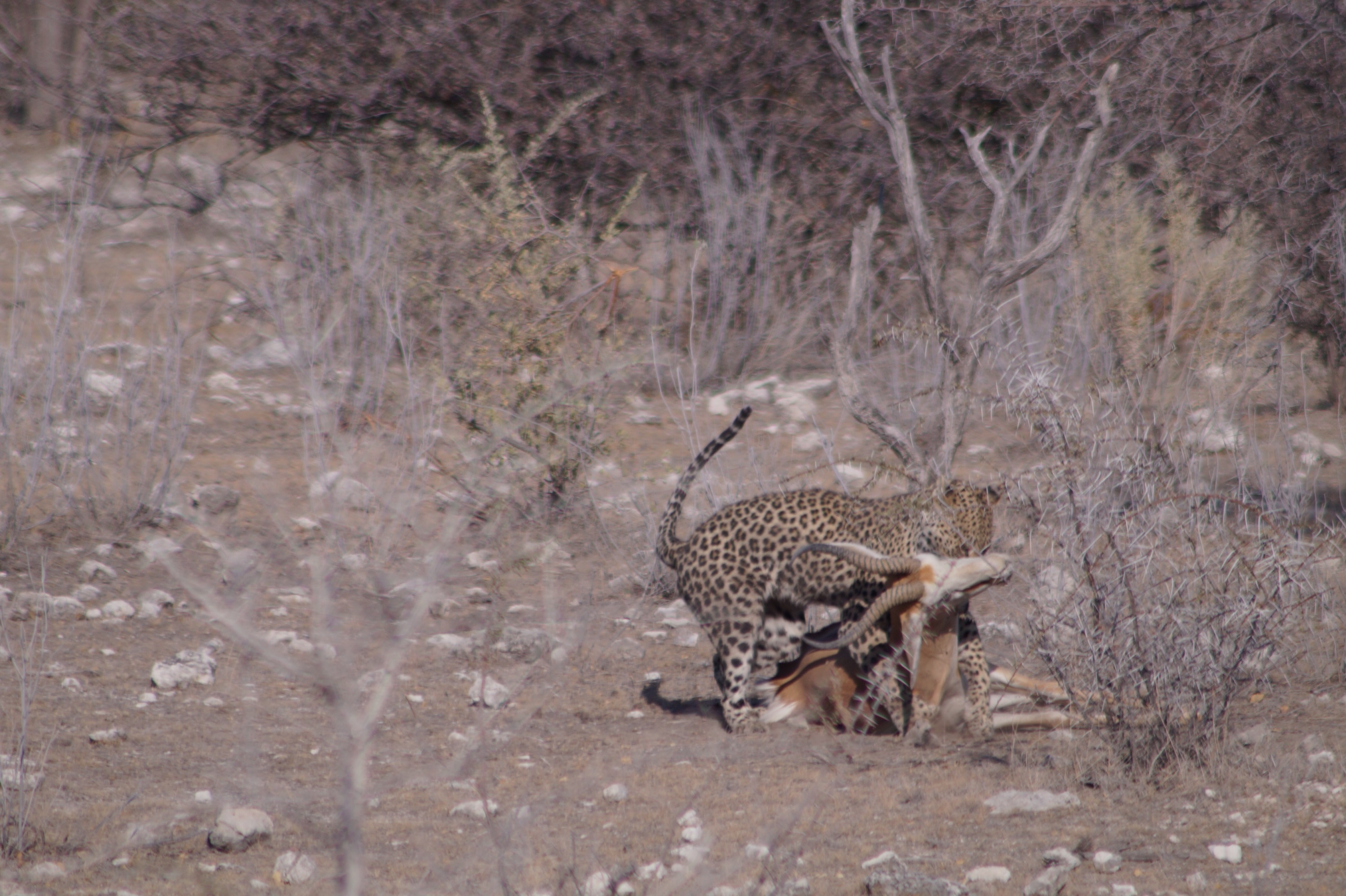 Our luck wasn't over though. One animal we had not seen was cheetah which are only present in low numbers in Etosha. I had checked the sightings book at Namutoni camp reception and there seemed to be a prevalence of cheetah sightings on a certain route out from camp. So late that afternoon we set out hoping to catch sight of an elusive cheetah. Less than half way around the drive we came across a cheetah with two cubs on a springbok kill (clearly not a good day for springbok). From the size of the cubs bellies the kill had been made some time ago and the whole family had feasted well. The jackels were closing in and we watched for over an hour as the young cubs kept chasing them away from the kill.
Our luck wasn't over though. One animal we had not seen was cheetah which are only present in low numbers in Etosha. I had checked the sightings book at Namutoni camp reception and there seemed to be a prevalence of cheetah sightings on a certain route out from camp. So late that afternoon we set out hoping to catch sight of an elusive cheetah. Less than half way around the drive we came across a cheetah with two cubs on a springbok kill (clearly not a good day for springbok). From the size of the cubs bellies the kill had been made some time ago and the whole family had feasted well. The jackels were closing in and we watched for over an hour as the young cubs kept chasing them away from the kill.
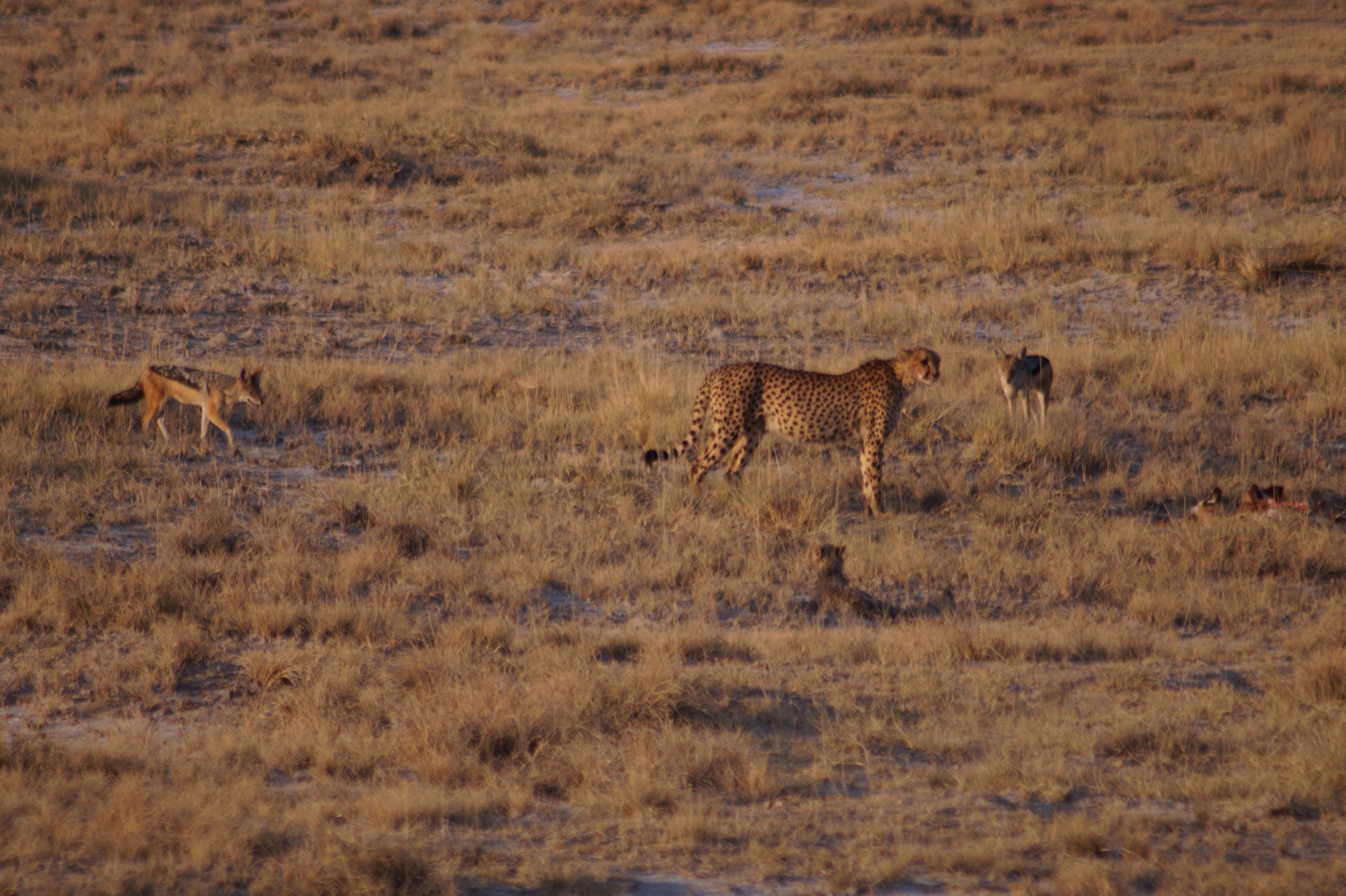
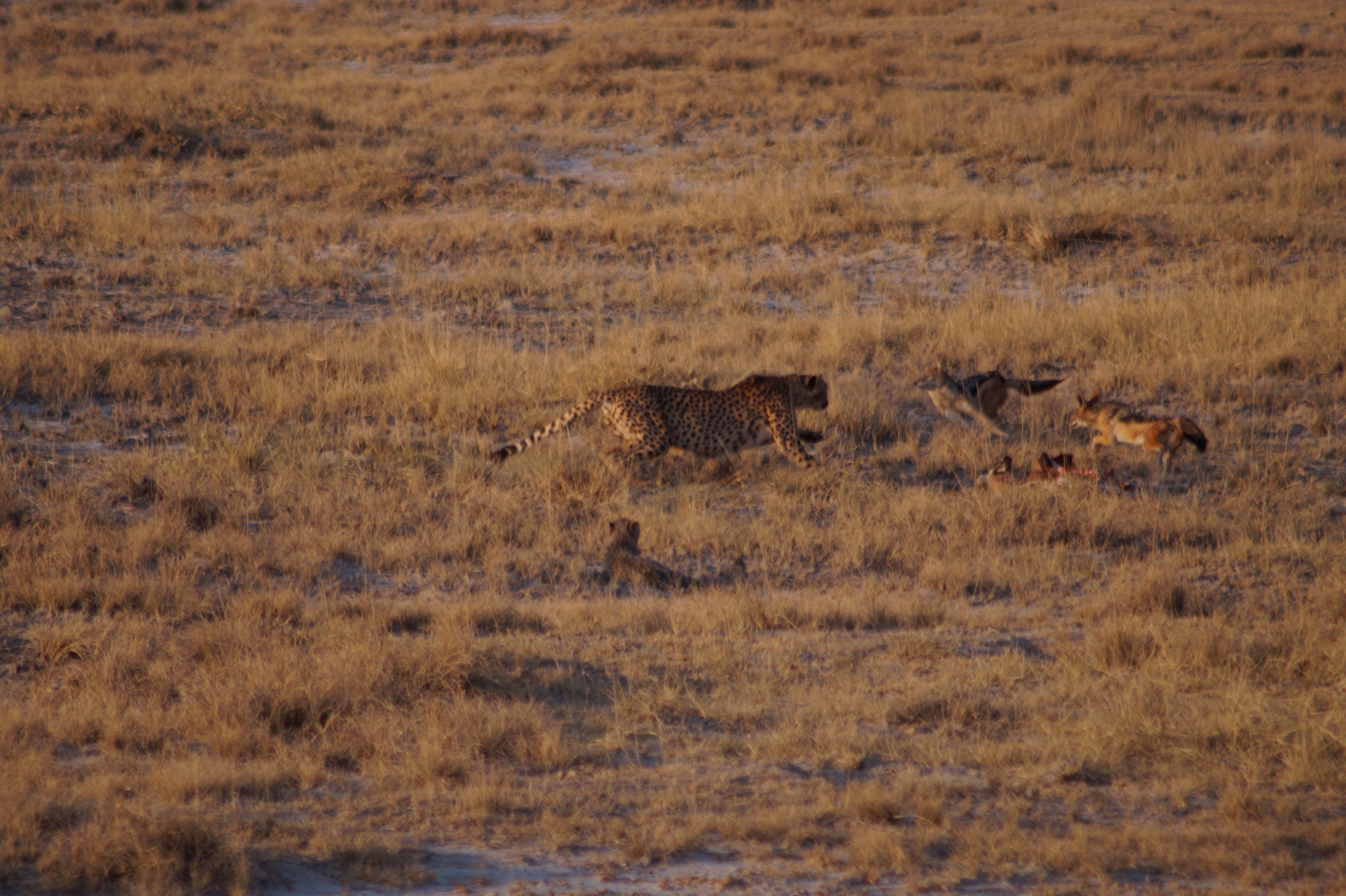 We loved Etosha and been able to watch the stories unfold in front of us. Whilst it was " busy" it never felt packed. Nearly all the tourists were driving themselves in cars with camping equipment and it's a great park for this type of trip. It's lovely just to be able to sit by the waterholes and watch the animals come down to drink. And if you are lucky you might get to see something really special.
We loved Etosha and been able to watch the stories unfold in front of us. Whilst it was " busy" it never felt packed. Nearly all the tourists were driving themselves in cars with camping equipment and it's a great park for this type of trip. It's lovely just to be able to sit by the waterholes and watch the animals come down to drink. And if you are lucky you might get to see something really special.
